Items tagged with 'economy'
Future jobs, done by humans and not
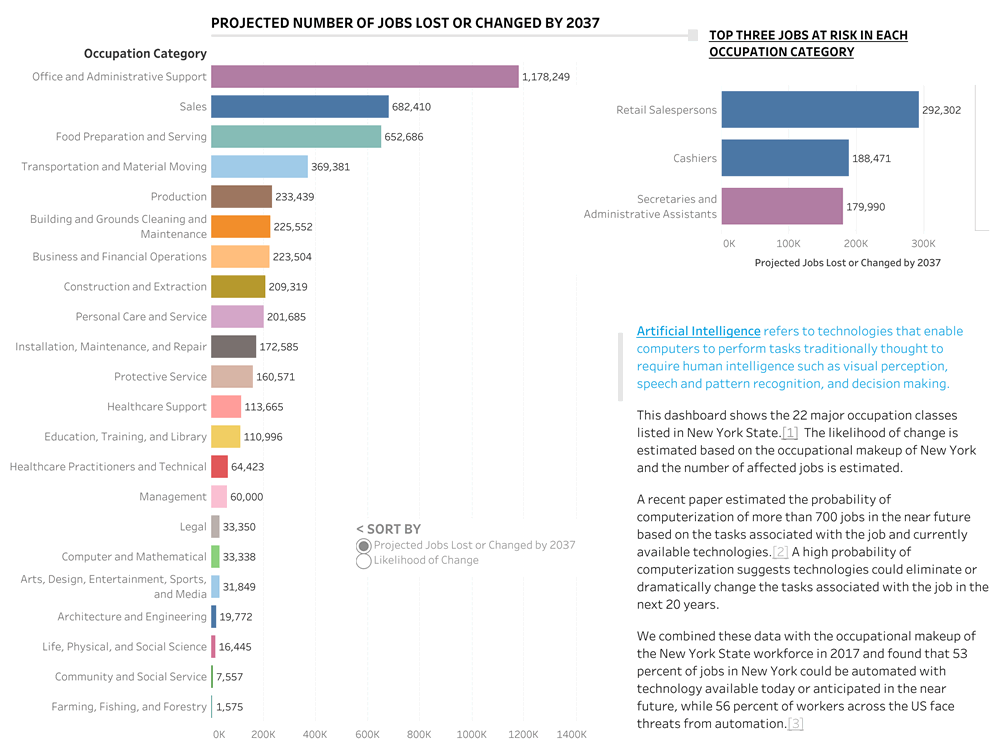
Roughly half of the jobs in New York State could be automated or otherwise significantly changed by artificial intelligence over the next 20 years. That's from an ongoing look at the issue by the Rockefeller Institute of Government here in Albany. From a post by Rockefeller's Laura Shultz:
The calculation is based on individual occupations. A recent paper by Frey and Osbourne estimated the probability of computerization of more than 700 jobs in the near future based on the tasks associated with the job and currently available technologies.[1] A high probability of computerization suggests technologies could eliminate or dramatically change the tasks associated with the job in the next twenty years. We combined these data with the occupational makeup of the New York State workforce in 2017 and found that 53 percent of jobs in New York could be automated with technology available today or anticipated in the near future, while 56 percent of workers across the US face threats from automation.[2]
Rockefeller has put together an interactive graphic that highlights the number of jobs -- by industry and type -- that could be affected around the state. (That image above is a static version of the graphic.) At the top of the list are office support, retail salespeople and cashiers, and food service -- potentially 2.5 million jobs lost or changed.
This struck us as a key clip from Shultz's post (emphasis added):
How the Albany metro area compares favorably to places such as Boston, DC, and Austin
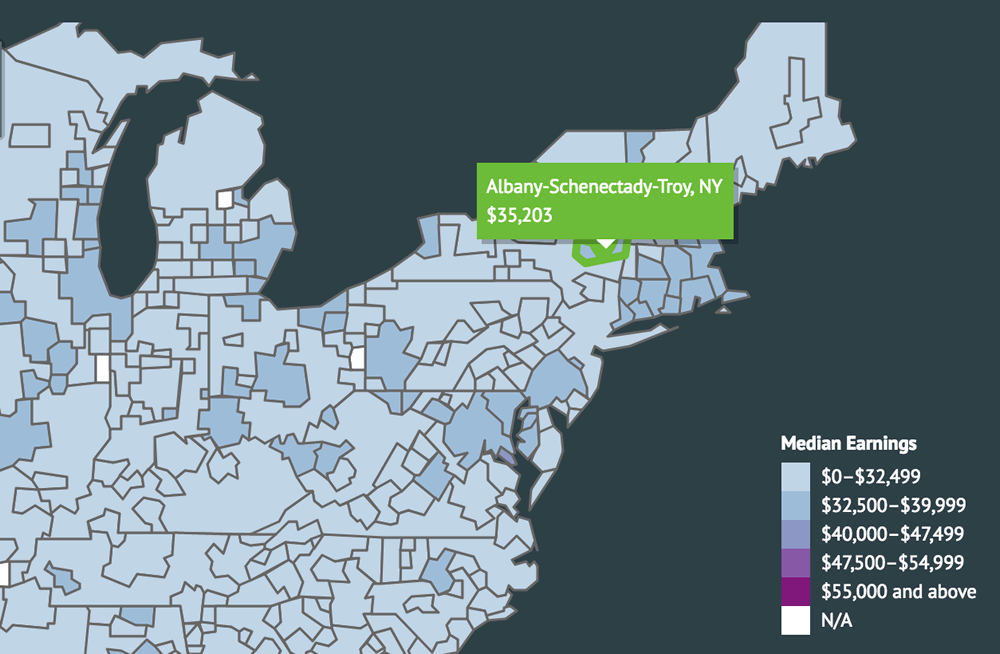
This is a screengrab from the Hamilton Project interactive visualization.
We were having a conversation the other day with someone about some of the things people who don't live here -- especially people from larger metros -- might not understand or appreciate about the quality of life here.
And one thing that immediately sprang to mind: There are (relatively) good job opportunities in the Albany metro area, and the (relatively) low cost of living means you can live here (relatively) comfortably without having to scrape like you would in a lot of big/coastal metros.*
That point is illustrated by this interesting interactive data visualization from The Hamilton Project at Brookings -- it depicts median income by occupation and age across the nation's 300some metro areas. (It's attached to an analysis aptly titled "Where Work Pays: How Does Where You Live Matter for Your Earnings?")
And here's the important thing: it gives you the option to adjust for cost of living and taxes.
So how's that work out for Albany?
Capital Region rent, relatively speaking
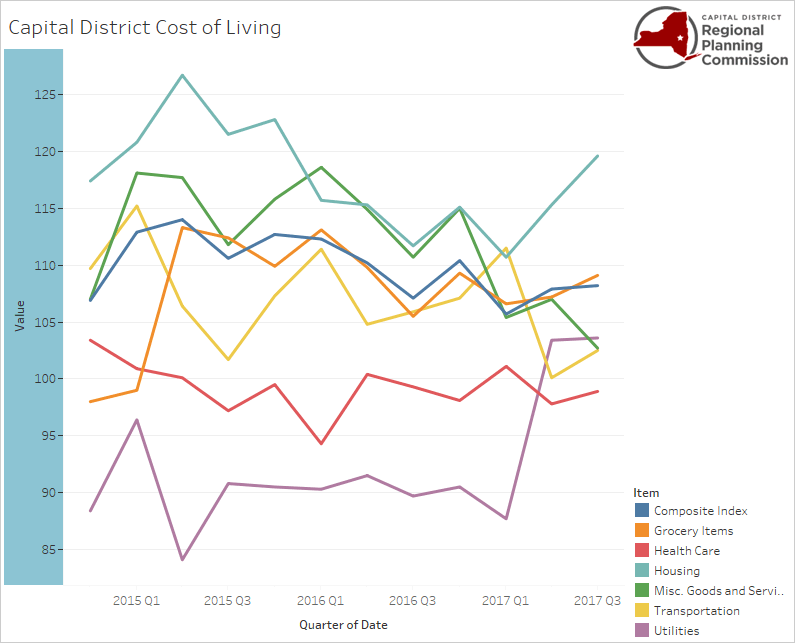
This graph is from the Capital District Regional Planning Commission and the Council for Community and Economic Research. It tracks a Capital Region cost of living measure relative to the national average quarter by quarter. That teal line running along the top is the cost of housing.
Speaking of residential develop and rents and related whatnot...
+ The median gross rent for Albany-Schenectady-Troy metro area was $931 (+/-21) in 2016, according the Census Bureau*. In the city of Albany it was $895 (+/-29). That is, half the rents (plus utilities if not included) were above that mark and half were below.
+ In 2007, the median gross rent for the Albany metro was $779 (+/-18) and for the city of Albany $746 (+/-37). The 2016 rent levels mentioned above are an increase of almost 20 percent in both cases. That increase outpaced general inflation for the United States -- if both had risen at the pace of general inflation, they would have been at $900 and $862.**
The Capital Region leads Upstate in job growth

The Capital Region led Upstate New York* in employment grown between 2009 June and 2016 June -- that's from a new report by the state comptroller's office. The Capital Region* was up 2.2 percent over that period, while all of Upstate employment was up just 0.3 percent. It was one of just three (of eight) regions Upstate to see employment growth.
So... good for the Capital Region, right? Yep, but it's not all great.
Here are a few more interesting bits from the report about jobs Upstate...
One thing that sticks out about prices here
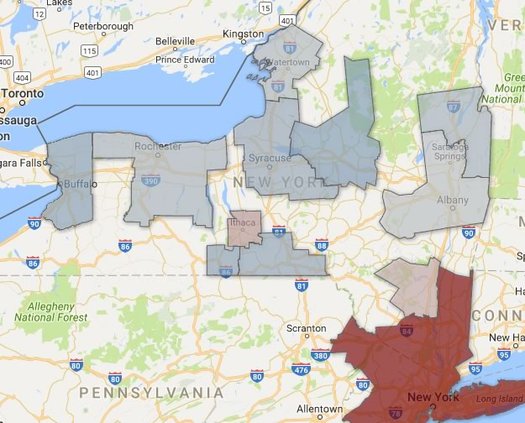
You might have seen that map floating around online recently about "the real value of $100 in each state" -- and New York State had one of the lowest "real" values of any state.
That map was based on figures published by the federal Bureau of Economic Analysis. And one of those figures is something called the regional price parities (RPPs) -- an attempt to measure how much goods and services cost in an area compared to the rest of the country.
You can probably now guess why the state level number for New York is kind of misleading -- if you're lumping in numbers for New York City with numbers for, say, Utica, it's going to be skewed. And to the credit of the think tank that made that state map -- the Tax Foundation -- it followed up this week with a similar map based on metro areas.
Anyway, this is just a long setup for looking at RPPs for metro areas around New York State. There's a static map above for the RPPs for all items across the state's metro areas -- and a clickable map after the jump. And as you can see, most parts of upstate have prices that are about average for the nation -- or lower.
Which is probably what you might expect -- except for one category...
The Capital Region's largest private employers*
* According to the state's RFP for the Harriman campus land sale
Tucked in that request for proposals for the sale of part of the Harriman State Office Campus in Albany was an interesting list: The largest private-sector employers "within commuting distance" of the site.
We've seen similar lists before. The state Department of Labor publishes lists for the state and individual regions (last update March 2014). But that list doesn't include job counts (the labor department cites confidentiality) -- and the one in the RFP does.
So, can you guess the largest private-sector employers in this area? We'll give you a few hints: healthcare and supermarkets...
Getting some sense of New York's upcoming minimum wage increases

As you know, New York State's minimum wage -- or, really, its minimum wages -- are set for large increases over the next handful of years. Areas downstate will eventually hit $15 an hour, and upstate will rise to $12.50, with continued increases planned after that.
Last year during the debate about whether the state should take this path, we tried to get some sense of the proposed increase by comparing the minimum wage to the wages of everyone else in the state. And we did this by region, because making $15 an hour in New York City isn't necessarily the same as making $15 an hour in Utica.
So now that the increases are set, we thought we'd run that comparison again. And we added a new one -- using the cost of housing as a yard stick.
5 bits about jobs in the Capital Region -- and how much they pay

We hear George does this job for free.
Which jobs in the Capital Region pay the most? Which pay the least? Which are the most common? Which are much more common here than other places?
Those are the sorts of questions to which we can an answer from a set of numbers of published by the federal Bureau of Labor Statistics. And, as it happens, the BLS released a new batch of those numbers this week.
And given all the recent discussion about New York State increasing its minimum wage, it seemed like a good time to pick out some bits from the new numbers.
Cuomo moving to raise minimum wage for state employees to $15 per hour

The Cuomo admin announced Tuesday that Andrew Cuomo is moving to unilaterally set a $15 minimum wage for state employees.
The increase would be phased in over the next few years, rising to $15 in New York City by the end of 2018, and by 2021 in the rest of the state. It's projected the increase would affect approximately 10,000 state employees -- 9,000 of them outside New York City.
The governor publicly announced the plan at a Fight for 15 rally in New York City. "This is about basic fairness and basic justice," he said of the push to raise the minimum wage both in New York State and across the country. "We're going to lead the way. The nation's going to watch us."
Degrees of difference between women and men
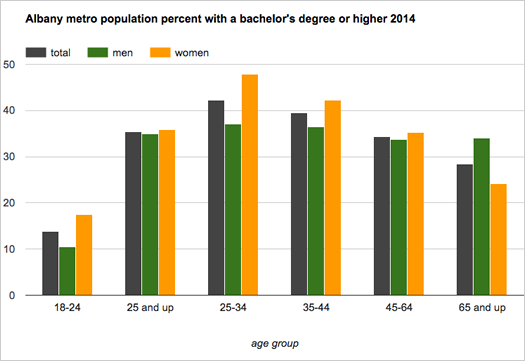
More women than men in the United States had a bachelor's degree or higher in 2014 -- 30.2 percent of women, compared to 29.9 percent of men, according to Census Bureau estimates. And as the bureau pointed out today, it's the first time that's happened nationally since the bureau started tracking the number in 1940.
We were curious about about the numbers for the Capital Region, so we looked 'em up for the Albany-Schenectady-Troy metro area. They're smashed into the chart above.
And here's a bit more...
A snapshot of Capital Region income

How the Albany-Schenectady-Troy metro compares to the nation's 381 other metro areas.
The Albany metro area continues to have one of the nation's higher median household incomes, and one of the the lower rates of poverty, according to the newest estimates from the Census Bureau.
Household income
The median household income in the Albany metro -- the point at which half the households had more income, and half had less -- was an estimated $62,265 (+/-1,494) in 2014. That's up just a bit from 2013 -- $59,626 (+/-1,981) ($60,593.25 in 2014 dollars). And it ranks 41st among the 381 metropolitan statistical areas the Census tracks.
Poverty rate
The Albany metro area's poverty rate was an estimated 11.7 percent (+/- 0.9). (It was 12.5 percent (+/-1.0) in 2013.) The metro's poverty rate was the 51st lowest among the 381 metros, lower than 87 percent of them. The Capital Region's poverty rate for kids wasn't quite so low -- an estimated 17.1 percent (+/-2), lower than 76 percent of metros.
Income inequality
Another angle on income and poverty is income inequality. And for that the Census Bureau publishes a figure called the Gini index -- a Gini index of 1 means only person has all the income, and 0 means everyone in a group has the same level. The Capital Region's Gini index for 2014 -- an estimated .4357 (+/-0.0119) -- was the 80th lowest (that is, toward the more equal end) among metropolitan areas.
Even if those three measure look relatively good for the Capital Region, there are still some troubling parts to the picture.
Getting some sense of a $15-per-hour minimum wage

When Andrew Cuomo recently proposed raising the state's minimum wage for all industries to $15, it created a big stir -- in large part because that's a big jump from the state's current minimum wage of $8.75 (soon to be $9). And it highlights the question: What is the "right" minimum wage?
Here's one way of thinking about that question for different parts of New York State...
Cuomo: Raise New York State's minimum wage to $15 an hour for all industries

Cuomo announced the push during an event in New York City with Joe Biden.
Updated
Andrew Cuomo announced Thursday that he will be pushing to raise the state's minimum wage to $15 an hour. The announcement accompanied word from the governor that the state Department of Labor has accepted the wage board recommendation that the minimum wage for fast food workers increased to $15 an hour.
Cuomo's push to raise the overall state minimum wage isn't that surprising (even if he had downplayed the push for $15 earlier this year). He had tried to get the legislature to accept an increase to $10.50 ($11.50 in NYC) during the last legislative session. And the fast food wage board plan was pretty clearly an attempt to out maneuver the opposition in the legislature. (State Senate Republicans -- the most likely road block to the minimum wage increase -- criticized Cuomo's handling of the fast food wage increase Thursday.) [NYT] [Politics on the Hudson]
Invoking the memory of both FDR and his father, Andrew called the proposed increase as matter of economic justice. "You cannot support a family on 18,000 a year in New York State, not to mention having a decent living," he said with Joe Biden looking on in New York City. "Every working man and woman in the state of new york deserves $15 an hour as a minimum wage and we're not going to stop until we get it done."
How much does it cost to have "a secure yet modest standard of living"?

Clipped from the Economic Policy Institute Family Budget Calculator. Numbers are in 2014 dollars.
A family budget calculator posted online Wednesday by a think tank -- Economic Policy Institute -- aims to to answer that question for metro areas around the country. A few of the results for the Albany area posted above. (Here's a Washington Post interactive using the data that gives a quick look at how a metro stacks up against the rest of the nation.)
A bit of blurbage about the calculator:
Poverty thresholds are generally national income levels used to measure the number and share of Americans who are economically deprived. Conceptually, these measures are important metrics, but are fundamentally different from EPI's basic family budgets. Families above poverty thresholds are just thought to be free of outright material deprivation. In contrast, family budgets offer a broader measure of economic adequacy by measuring the dollar amount necessary for families to live securely but modestly in various communities across the nation.
As with anything like this, the methodology is going to make a difference in the outcome, and EPI documents the recipe it used.
One thing that caught our eye right away was the cost of child care. While it wasn't surprising that it was expensive, we wouldn't have guessed it was quite that much. A look through the methodology reveals that the cost of childcare is from data published by state. So it's possible the number is inflated a bit by the downstate cost. (Now we're curious about the cost of day care here in the Albany metro area...)
Earlier on AOA: A few ways of thinking about the minimum wage
Where the commuters are from
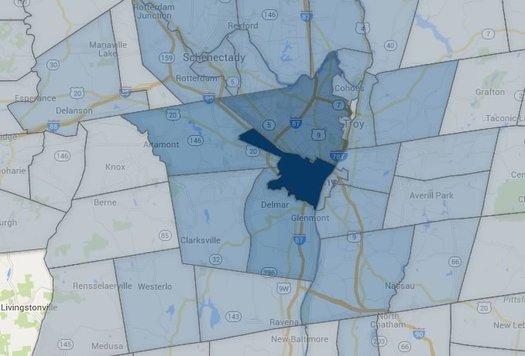
The city of Albany draws commuters from a wide area.
Each weekday in the Capital Region a large tide of people wash into the area's urban centers for their work days, and then stream back home. So large is this tide for the city of Albany that its daytime population during the week rises by 2/3.
So, where do all these people come from? Well, thanks to some recently released Census data, we can some sense of an answer to that question. And to extend the water metaphor a bit further, we can map out the "commuter sheds" that drain into each of the Capital Region's urban centers each weekday.
So let's have a look.
Jobs gained and lost
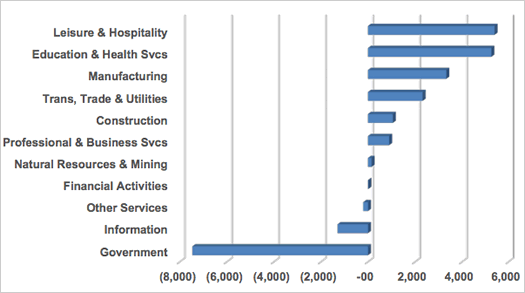
"Government" also includes jobs such as public school teachers. / graph: NYS OSC
That graph above depicts the numbers of jobs gained and lost, by sector, in the Capital Region between 2009 and 2014. It's from NYS Comptroller's Office report out Monday looking at employment trends across the state.
That might sound like a snore-inducing document, but it collects a bunch of bits that help fill out the picture on what's happening (or not happening) in the economy. A few of those interesting bits...
New York State set to raise fast food minimum wage to $15 per hour
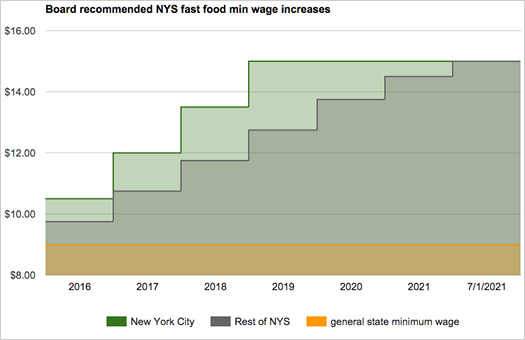
The state Fast Food Wage Board has recommended that the minimum wage for fast food employees across New York State rise to $15 per hour -- eventually.
The board's recommendation, which now heads to the state labor commissioner before it can take effect, lays out two tracks for increasing the industry's minimum wage, for New York City and areas outside the city:
New York closer to $15/hour for fast food workers?
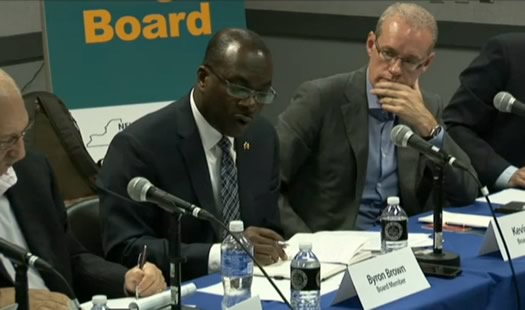
Buffalo mayor Byron Brown, chair of the fast food wage board, at Monday's meeting. / screengrab: NYS DOL livestream
At its last scheduled public meeting Monday the state's Fast Food Wage Board didn't recommend a specific increase in the minimum wage for fast food workers in the state -- but its members' comments pointed toward them eventually recommending a significantly higher rate.
"There's no question in mind that we need a very substantial increase in the minimum wage," board member Kevin Ryan, the chairman and founder of the online shopping site Gilt, said.
"When you look at the industry as a whole in this state, we really should be looking at one wage rate for the state, and that should be $15 and that should be as soon as possible," said board member Mike Fishman, the secretary treasurer of Service Employees International Union.
The fast food wage board was empaneled by the state Department of Labor at Andrew Cuomo's direction in May to consider raising the minimum wage in the industry. The Cuomo admin says the board's recommendation can be enacted without legislation.
On order: Another look at the minimum wage
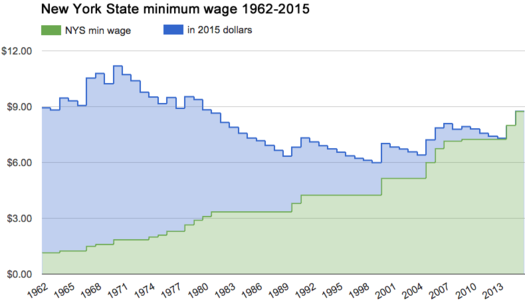
A minimum wage consistent across many industries in New York State dates back to 1962. Here's how it's increased over time, with a comparison in 2015 dollars for some perspective. (Inflation calculations via the federal Bureau of Labor Statistics calculator.)
This chart is recycled from last month, when we put together a bunch of different ways of putting the level of the minimum wage in context. With Andrew Cuomo talking again this week about raising the minimum wage, specifically for fast food workers, we figured it was a good time to highlight that post again.
From Cuomo's op/ed in NYT:
Fast-food workers and their families are twice as likely to receive public assistance compared with other working families. Among fast-food workers nationwide, 52 percent -- a rate higher than in any other industry -- have at least one family member on welfare.
New York State ranks first in public assistance spending per fast-food worker, $6,800 a year. That's a $700 million annual cost to taxpayers.
(Update: See this Capital article about an error in Cuomo's op/ed regarding the number of fast food workers who are raising children.)
The median hourly wage -- that is, the point at which half the people make more and half make less -- for fast food cooks in the Albany metro area was $9.25 per hour in 2014 May, according to numbers published by the federal Bureau of Labor Statistics, with an annual average wage of $20,520. The BLS also breaks out numbers for "combined food preparation and serving workers, including fast food," and the median wage for the Albany metro area was $8.93.
The median hourly wage for restaurant cooks generally in this area was $11.48 per hour, $9.89 for servers, and $9.13 for dishwashers. (Here are the same sets of numbers for New York State generally.)
Elsewhere: Back in March Steve Barnes looked at how an increase in the minimum wage for tipped employees was set to affect restaurants -- and non-tipped restaurant employees such as dishwashers.
If place matters, why specifically?
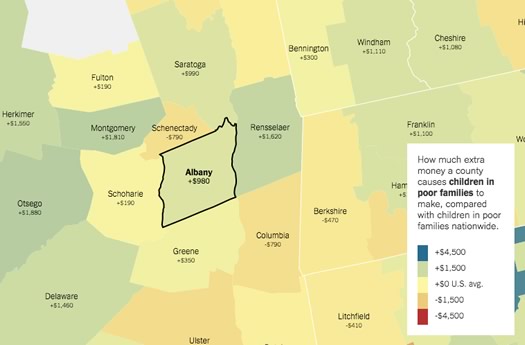
A clip from the interactive map at NYT's The Upshot.
Sometimes information raises more questions than it answers.
We were thinking about that today while looking through this impressive New York Times interactive piece about a new study that examines how place affects the income mobility of children. A clip:
The main innovation of the new paper -- part of the Equality of Opportunity Project, involving multiple researchers -- is its focus on children who moved. Doing so allows the economists to ask whether the places themselves actually affect outcomes. The alternative is that, say, Baltimore happens to be home to a large number of children who would struggle no matter where they grew up.
The data suggests otherwise. The easiest way to understand the pattern may be the different effects on siblings, who have so much in common. Younger siblings who moved from a bad area to a better one earned more as adults than their older siblings who were part of the same move. The particular environment of a city really does seem to affect its residents.
The data does not answer the question of whether the factors that distinguish higher-mobility places, like better schools and less economic segregation, are causing the differences -- or are themselves knock-on effects of other, underlying causes. "We still need clarity on that," Mr. Grusky, the Stanford professor, said.
There are a lot of important details beyond that clip, and it's worth reading that article and the accompanying pieces. Here's economist Justin Wolfers arguing that the study "makes the most compelling case to date that good neighborhoods nurture success."
So, we've been poring over the results for the Capital Region and they raise a lot of questions. For example:
A few ways of thinking about the minimum wage

The "Fight for 15" rallies got a lot of attention around the country this week, including here in the Capital Region, as people pushed for an increase in the minimum wage.
The current minimum wage in New York State is $8.75 per hour. It's scheduled to increase to $9 at the start of next year.
A lot of numbers get thrown around in these discussions, and sometimes it can be hard to keep in them context. So we put together a few easy-scan charts in an effort to get a better sense of things...
Siena poll: Majority support minimum wage increase to $10.50 per hour
 When given the choice of letting the New York State minimum wage rise to the already-scheduled level of $9/hour next year or raise it to $10.50 per hour, almost 3/4 of respondents in a Siena poll out today picked the $10.50 level.
When given the choice of letting the New York State minimum wage rise to the already-scheduled level of $9/hour next year or raise it to $10.50 per hour, almost 3/4 of respondents in a Siena poll out today picked the $10.50 level.
Here's the question text from the Siena poll, because it was a little complicated:
The current minimum wage in New York State is eight dollars seventy-five cents per hour. It is scheduled to go to nine dollars per hour next year. When it comes to the minimum wage, among the following three choices, do you agree more with the State Senate, which wants it kept at nine dollars per hour, OR Governor Cuomo, who wants it increased to ten dollars fifty cents per hour, OR the State Assembly, which wants it increased to ten dollars fifty cents per hour now, with provisions to go higher in future years?
And the answer options:
+ "State Senate, which wants it kept at nine dollars per hour": 26 percent of all respondents
+ "Governor Cuomo, who wants it increased to ten dollars fifty cents per hour": 20 percent of all respondents
+ "State Assembly, which wants it increased to ten dollars fifty cents per hour now, with provisions to go higher in future years": 52 percent of all respondents
The $10.50/hour options drew the combined support of more than 65 percent in each of the three income categories for respondents -- less than $50k, $50-$100k, and $100k+. And it also had at least 50 percent support from both Democrats and Republicans.
The Siena poll also asked about the idea of a having a higher minimum wage downstate -- the yes/no split on that was 47/51 for all respondents. NYC respondents supported 55 percent, it was essentially even for people in the downstate suburbs, and upstate respondents opposed it 63-43.
The Siena Research Institute says the poll was conducted March 15-19 and has a +/- 3.5% margin of error.
Leaning toward renting
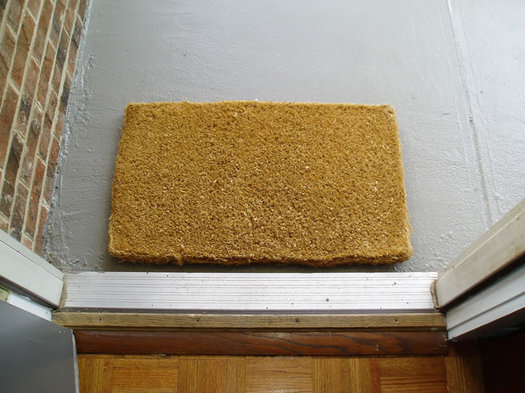
Home sweet (rented?) home. / photo: Flickr user Joelk75 (CC BY 2.0)
Last week we wrote about one of the residential conversions in progress in downtown Albany. As is so often the case, a prominent thread in the comments was the rental price. And then chris capped things off with this comment:
Hey, when people start buying houses again this place will be half-empty and they'll have to drop the rent. Have patience...
We were thinking about how chris framed the situation -- essentially, people are leaning away from buying houses right now and toward renting -- and wondering if we could get a better sense of the situation.
Are there numbers on that? Of course. Did we look them up? Of course. Are we now going to share some of the numbers with you, with graphs? Of course.
The Capital Region's unemployment rate continues to drop

The Capital Region labor force since 2000. Here's a bigger version.
The Capital Region's unemployment rate was 4.8 percent in September -- one of the lowest rates of any metro in the state -- according to figures out this week from the state Department of Labor. And it was down from 6.1 percent in September 2013.*
New York State's unemployment rate was 5.6 percent in September, down from 7.4 percent the year before. And the upstate unemployment rate was 5.5 percent, down from 6.9 percent the year before.
The numbers for September continue a trend for the Capital Region in which each month's unemployment rate has been lower than that same month the year before, dating back to 2012 November.
Nordstrom Rack to open at Colonie Center
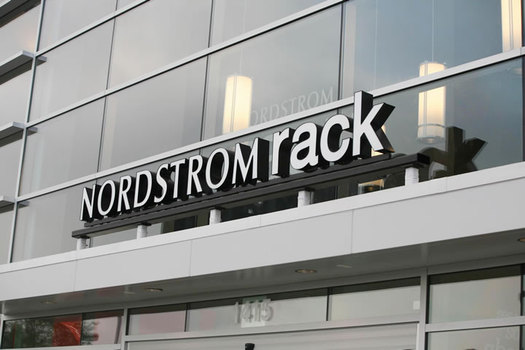
Nordstrom announced Wednesday that it's opening one of its Nordstrom Rack stores at Colonie Center in fall 2015. The company says it will be a two-level store -- roughly 35,000 square feet (roughly the same size as the new Whole Foods there) -- and it sounds like it will be in the same end of the mall as Sears.
Nordstrom Rack is the discount outlet for the upscale department store chain. The company says Rack offers "customers a wide selection of on-trend apparel, accessories and shoes at an everyday savings of 30-70 percent off regular prices."
As it happens, there are more Nordstrom Racks (162) than full Nordstroms (118). And the Colonie Center is one of 22 Nordstrom Rack locations the company has announced it plans to open in 2015.
It's interesting to us that, for whatever reason, the Capital Region appears to be getting attention from higher-end retailers over the last few years. Fresh Market has two locations in the region, Whole Foods opened earlier this year, Lord & Taylor returned at Crossgates just recently, and now (the not-quite-so-high-end-version of) Nordstrom.
We're curious if that points to something shifting in the demographics of this area. (More high-income households because of the nano/chip fab industry, maybe?) Or is it just that these upscale retailers have already expanded everywhere else and they're just getting around to the Capital Region.
Earlier on AOA: What "they" say about here
photo courtesy of Nordstrom, Inc.
Saint Rose adjuncts vote to unionize
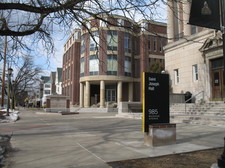 Adjuncts at the College of Saint Rose have voted to unionize with SEIU Local 200 by a tally of 175-61. In a statement, Saint Rose said it "will work with the SEIU to address the issues concerning the adjunct faculty." [Supporters of Saint Rose Adjunct Faculty FB group] [College of Saint Rose]
Adjuncts at the College of Saint Rose have voted to unionize with SEIU Local 200 by a tally of 175-61. In a statement, Saint Rose said it "will work with the SEIU to address the issues concerning the adjunct faculty." [Supporters of Saint Rose Adjunct Faculty FB group] [College of Saint Rose]
Contingent labor is a big issue across higher education right now. Adjuncts make up a majority of nation's faculty work force -- all the while they often make much less than tenure-track faculty and have little job security. And in recent years at campuses around the nation there has been a rising call for unionization. [Chronicle of Higher Ed] [US House Committee on Education and the Workforce] [NYT]
Earlier on AOA: Work Week: Con Job: Stories of Adjunct and Contingent Labor
The College of Saint Rose advertises on AOA.
How New York and the Capital Region compare on income inequality
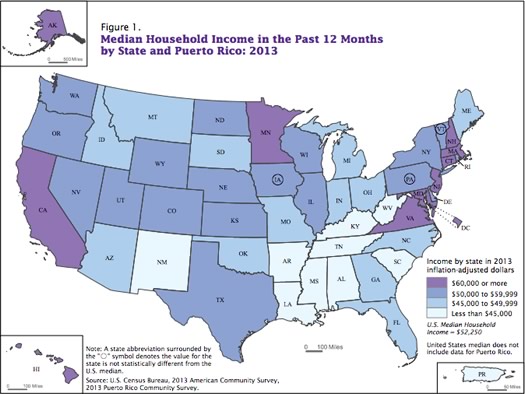
States by median household income in 2013. / map: US Census Bureau
Income inequality has been a much-discussed topic over the last few years, so some new numbers about income -- and income inequality -- out this week from the Census Bureau caught our eye.
As part of the income data from the 2013 American Community Survey, the Census Bureau released Gini coefficients for various places -- these numbers are the result of calculation intended to give a sense of how income is distributed within a group of people, usually a nation. It's a very common of income inequality when comparing countries.
So we were curious to see how New York -- and the Capital Region -- compared to the rest of the nation...
New York has a big economy, but...
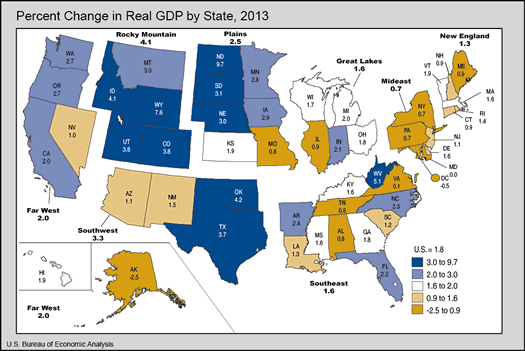
New York State has one of the biggest GDPs in the country. But its GDP didn't grow much last year. / image: US Bureau of Economic Analysis
Macroeconomic fact of the day: New York's gross domestic product (GDP) was $1.3 trillion in 2013, according to figures out this summer from the federal Bureau of Economic Analysis. That ranked #3 in the nation behind California ($2.2 trillion) and Texas ($1.5 trillion).
So, that's very Empire State-ish, having one of the country's largest economies. And New York's GDP per capita ranked 7th in nation (8th if you count DC and its otherworldly rate). Again, pretty good.
But here's the not good: New York's 2013 GDP grew by just .7 percent compared to 2012, according BEA estimates. That was ranked 46th in the nation.
A table with numbers for New York and the other states is after the jump.
The Capital Region's biggest employers are...
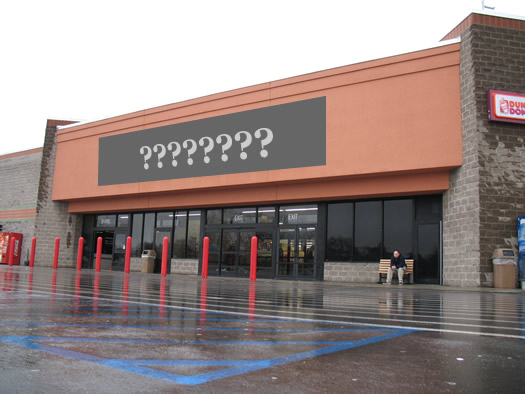
Can you guess? (This photo isn't really making it hard.)
Something we came across while doing research for that post earlier this week about the Capital Region jobs picture: The top 10 private sector employers for the Capital Region, as counted by the state Department of Labor.
Can you guess which companies are on the list?
A view of the Capital Region jobs picture
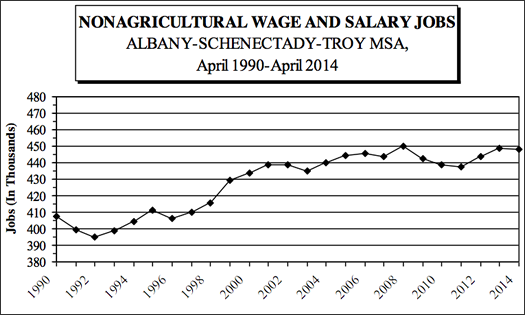
Graph via the NYS Department of Labor.
The Capital Region's unemployment rate was 4.8 percent in April, the state Department of Labor reported this week. That's down from 6.3 percent in April 2013. (The state's overall unemployment rate was 6.1 percent.)
Hooray, right?
Well, sort of. If you look at the numbers you'll also notice that the number of jobs in the Capital Region is also down so far this year.
So, what's going on?
This just in: New York has high taxes
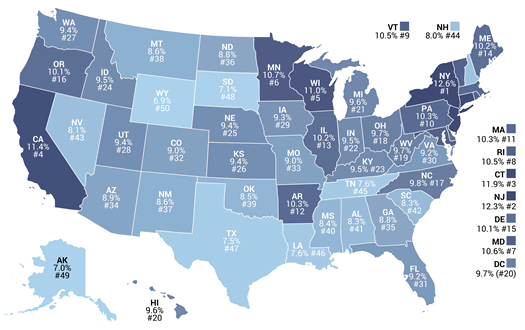
A map created by the Tax Foundation based on its calculations, the deeper the blue the higher the percentage of income in a state that goes to state and local taxes.
New York State once again topped the Tax Foundation's annual list of highest state-local "tax burdens" as a percentage of income. The think tank calculates that 12.6 percent of income in New York goes to state and local taxes . (The US average is 9.8 percent.) The figures are for fiscal year 2011.
It's the third straight year New York has topped the list. It's joined in the top three by New Jersey and Connecticut, a trio the Tax Foundation reports has held the three spots since 2005. Somewhat interesting to us: New York's rate has more or less held steady over the last 35 years, according to the rankings.
New York's place in the top spot isn't surprising. But when it comes to these sorts of lists we'd like to also see what people are (or aren't) getting for the taxes they pay. A small, localized example: Property taxes in the city of Albany tend to be higher than some of the surrounding suburbs, but those taxes cover services -- like garbage collection -- that you might have to pay for separately somewhere else.
Highlighting what people are getting for their taxes wouldn't necessarily let New York State off the hook for its high-tax rep. But it might make some of the trade-offs more clear and specific.
The Tax Foundation describes itself as an "independent tax policy research organization." Here's a run through of the methodology for its tax/income calculations.
Consolidation
The Cuomo admin has been pushing consolidation and shared services as a way for local governments to save money (and, you know, not raise taxes). Over at Capital, Jimmy Vielkind has an article looking at the issue of New York's many, many layers of local of government -- and finds some of these layers more or less only exist on paper, and the touted savings from consolidation could be hard to come by.
Study: New York is at the heart of the nation's "temperamental and uninhibited" region

The more orange, the more cranky. (OK, not necessarily cranky, temperamental and uninhibited.)
New York State is at the heart of the "temperamental and uninhibited" region of the United State, according to new research. And that could be having an effect on a wide range of issues -- from politics, to migration, to economic development.
The paper (pdf) appears in the Journal of Personality and Social Psychology. The authors include a group who published similar research a few years back that identified New York State as one of the most neurotic states in the country. In this new research, the authors -- from Cambridge, University of Texas at Austin, and Finland -- aimed to pull together survey data on the "Big Five" personality traits to map the "psychological topography" of the United States, and concluded that there are three regions:
+ Friendly and Conventional - the Midwest and Southeast
+ Relaxed and Creative - West Coast, Rockies, Southwest
+ Temperamental and Uninhibited - the Northeast, near Midwest, and to some extent, Texas
Here's a clip from the discussion for the "temperamental and uninhibited" region:
The Temperamental & Uninhibited region comprises states predominantly in the MidAtlantic and Northeast. This region is made up of the quintessential Blue states. The psychological profile of the region is defined by low Extraversion, very low Agreeableness and Conscientiousness, very high Neuroticism, and moderately high Openness. This particular configuration of traits depicts the type of person who is reserved, aloof, impulsive, irritable, and inquisitive. There are disproportionate numbers of older adults and women in this region, in addition to affluent and college-educated individuals. Residential mobility is low here, and in fact, data from the U.S. Census (Ihrke & Faber, 2012) indicates that significant numbers of residents of this region are leaving the area. Residents of this region also appear to be politically liberal and not mainline Protestants. Overall, it appears that this psychological region is a place where residents are passionate, competitive, and liberal.
There's also some discussion speculation how these traits tended become pronounced here:
A shift in the job market?
Check out the Capital Region's unemployment rate over the first half of this year, in the table above. (The state Department of Labor released June's numbers this week.)
The state's numbers for metro areas are not seasonally adjusted, so the best comparison for a month is the same month the year before (or before that and so on). After a small increase in January, each month since has registered a bigger decline from its counterpart the year before
Six months isn't necessarily a lot of a time, but it looks like an encouraging trend. And maybe it is. Another way of looking at the situation is to count how many people are employed, as opposed to unemployed.* We've put together those numbers for the Capital Region over the same period in a table after the jump. The picture from that angle is not quite as bright, though June did register a nice increase.
One (another) thing that would be interesting to know: How the pay of these new jobs compares to that of the jobs people previously had.
Saratoga County: It tied Tompkins County (Ithaca) for lowest unemployment rate in the state in June, at 5.7 percent.
New York State: The state's unemployment rate was 7.5 percent in June, the lowest mark since February 2009. It was down from 7.6 in May, and 8.7 in June 2012. (Statewide rates are seasonally adjusted.) The state added 93,800 non-farm jobs between June 2012 and June 2013, an increase of 1.1 percent.
Capital Region's unemployment rate down a full percentage point compared to a year ago
 Following up on last week's bit that the state's unemployment rate hit a four-year low last month: The Albany-Schenectady-Troy metro area's unemployment rate was 6.4 percent in May, the state Department of Labor reported Tuesday. That's down from 7.4 percent in May 2012.*
Following up on last week's bit that the state's unemployment rate hit a four-year low last month: The Albany-Schenectady-Troy metro area's unemployment rate was 6.4 percent in May, the state Department of Labor reported Tuesday. That's down from 7.4 percent in May 2012.*
The state's unemployment rate was 7.6 percent in May.**
The unemployment rates in each of the metro's counties were down almost a full percentage point -- or more:
county: May 2013 / May 2012
Albany: 6.3 / 7.3
Rensselaer: 6.5 / 7.7
Saratoga: 5.8 / 7.0
Schenctady: 7.0 / 7.9
Schoharie: 8.0 / 8.6
As if often mentioned, the unemployment rate includes people who are actively looking for a job. So it doesn't necessarily provide a picture of how many people have become frustrated and stopped looking, chosen a different path because employment prospects aren't good (examples: going to school, staying home with a kid), are under-employed -- or some combination of all the above.
Lowest rate: The county with the lowest unemployment rate in May was Tompkins County, which includes Ithaca, at 5.1 percent. Coincidentally, it was also named the "smartest" city in the nation recently by a company that does online brain training games. [Syracuse.com via Gannett Albany Watch]
Meahwhile: 70 percent of American employees are not "engaged" at work, according to a Gallup report. [CBS News via TMN]
* Unemployment rates for counties are not seasonally adjusted, so the best comparison is the same month in previous years.
** State rate is seasonally adjusted.
State unemployment rate at lowest level in four years
 The unemployment rate in New York State was 7.6 percent in May -- the lowest mark since February 2009, according to the state Department of Labor.
The unemployment rate in New York State was 7.6 percent in May -- the lowest mark since February 2009, according to the state Department of Labor.
From May 2012 to May 2013 the state added 104,200 private sector jobs -- but that was blunted a bit by the loss of 18,500 public sector jobs (14,400 at the local level). During that same period, the Albany-Schenectady-Troy metro added 2,200 private sector jobs -- but lost 600 public sector jobs.
Statewide, the major industry sector that added the most jobs over the last year was "professional and business services" (up 40,400) -- the bulk of that gain was in "administrative and support services" (+24,600) and "professional, scientific and technical services" (+16,500). Next up: leisure and hospitality (+26,300). Interesting bit: of those leisure and hospitality jobs, 16,100 jobs were at "limited service eating places." (The effect of those multiplying Chipotles and Panerae?)
After the public sector, the industry to lose the most jobs statewide over the last year: manufacturing, down 13,300.
There were about 730k unemployed people in New York in May.
Zooming out on Capital Region unemployment
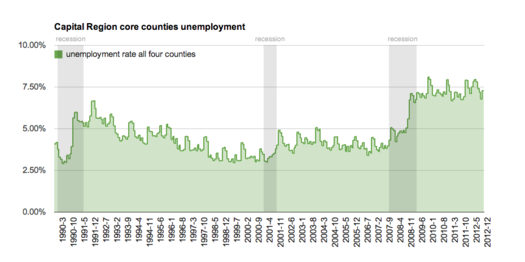
Don't squint. Here's a large-format version.
The state Department of Labor released unemployment data today for areas around the state -- and they were remarkably familiar, in a bad way.
The Albany-Schenectady-Troy metro area's unemployment rate was 8.4 percent in January. That was up from 8.2 percent in January 2012 -- though DOL reported there were about 2,000 more people employed this past January compared to the previous January. (The local area unemployment data isn't seasonally adjusted, so the best comparison is the same month the year before.)
Compared to the rest of the state, the Albany metro isn't doing so badly. It had basically the third lowest rate in the state, behind Ithaca (6.7) and the NYC suburbs/Long Island (7.9). Among the areas at the other end of the spectrum: Elmira (10.5), Glens Falls (10.3), and Utica/Rome (10.2). (The metro and county breakdown is post jump.)
The state's overall unemployment rate was 8.4 percent in January, the same as it was in January 2012. And it was up from 8.2 percent in December. (The statewide rate is seasonally adjusted, so month-to-month comparisons are OK.) The national unemployment rate was 7.9 percent.
A wider perspective
OK, the Albany metro's rate -- 8.4 percent -- seems high. How high? To put it in perspective, we pulled the unemployment data for the Capital Region's four core counties for 1990-2012. Large-format chartage is post jump.
GlobalFoundries building R&D center in Malta
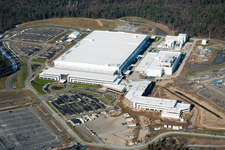 The Cuomo administration and GlobalFoundries officially announced today that GloFo will be building a $2 billion R&D center at Luther Forest. The target date for completion is late 2014. The new center is expected to prompt another 1,000 jobs at the site.
The Cuomo administration and GlobalFoundries officially announced today that GloFo will be building a $2 billion R&D center at Luther Forest. The target date for completion is late 2014. The new center is expected to prompt another 1,000 jobs at the site.
The Cuomo admin noted that "no new incentives were provided from the State" for this new project.
From a statement by GlobalFoundries CEO Ajit Manocha:
... [W]e are making significant investments in strengthening our technology leadership, including growing our workforce and adding new capabilities to make Fab 8 [that's Malta] the hub of our global technology operations. New York State's continued support of the semiconductor industry has created a strong collaborative ecosystem and helped pave the way for this additional investment. ...
The long-held hope has been that the Malta fab and the multiple investments at Albany NanoTech would push this area to become a cluster of tech-related projects, with its gravity pulling other stuff to it. Maybe that's starting to happen now. (And if that mysterious Project Azalea takes root here...)
Another small bit that points toward the tech actually being in Tech Valley: The TU's Larry Rulison noticed that Samsung has recently started trying to recruit "semiconductor talent" from the Albany area -- to go work in Austin.
photo: GlobalFoundries
Siena poll: many New Yorkers, especially upstate, not feeling better off than four years ago
 A few bits from the Siena Research Institute's "Annual New York Survey of the Economy and Personal Finances," out today:
A few bits from the Siena Research Institute's "Annual New York Survey of the Economy and Personal Finances," out today:
+ "Would you say you and your household are better off financially today than you were at this time four years ago or that you are not better off financially than you were in October 2008?"
better off: 35% | not better off: 47% | the same: 17% -- upstate, the split was 34/51/14.
+ When people were asked whether they thought businesses in their community were better off now than four years ago, 64% of people upstate said "worse off" compared to just 14% who said "better off." (The split was 56/17 statewide.)
+ Middle class people in your area, upstate response: 62% worse off | 8% better off | 24% about the same.
+ When asked if people thought the current economic problems were temporary, or "our country's best economic days are behind us" (temporary/behind us): Democrats 56/44 | Republicans 34/66 | Independents 51/49.
+ Support or oppose repealing the federal healthcare reform legislation?
Support: 40% | Oppose: 43% -- the split for Democrats: 29/56 | Republicans: 61/28 | Independents: 43/42
Here are the full cosstabs. SRI says the survey has a margin of error of +/- 3.9%.
Not a confidence-inducing 10 years or so

Consumer sentiment, from 1999 to the present -- via SRI.
The Siena Research Institute released consumer confidence figures today for metropolitan areas around the state. SRI reports that consumer confidence was up in every metro during the 3rd quarter of this year compared to the same period last year -- though it's down a bit in many metros compared to the last quarter. The Capital Region's Q3 figure was up 13 percent compared to the same period last year -- and down about 6 percent compared to the previous quarter).
Last week, SRI released numbers for the state as whole -- and September's figure was the highest in five years. Interesting bit: there was a huge gap between Democrats (95) and Republicans (58) -- 37 points -- the largest ever measured by SRI.
In general, rising consumer confidence is a sign that people think things are getting better and are more willing to spend money. That's usually a good thing for the economy.
The decade: The thing that really caught our eye today while browsing the SRI site: the chart above, which tracks consumer sentiment for both the nation (blue) and state (red) since 1999 until the present. It's not surprising -- and things appear to be getting better -- but, oof, the chart's another illustration it's been a rough decade or so.
chart: Siena Research Institute
Think tank: New York has the worst business climate in the nation because of taxes
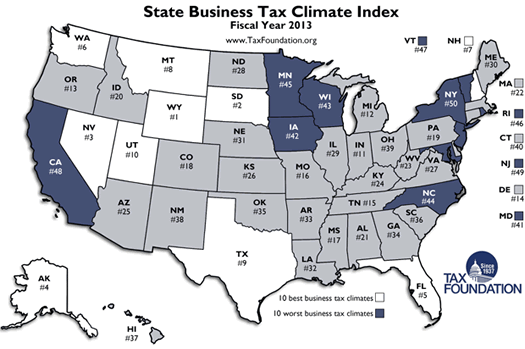
The Tax Foundation, a "non-partisan tax research group", has released its annual "business climate" index -- and New York State is at the bottom.
How the index is compiled:
The State Business Tax Climate Index, now in its 9th edition, collects data on over a hundred tax provisions for each state and synthesizes them into a single easy-to-use score. The states are then compared against each other, so that each state's ranking is relative to actual policies in place in other states around the country. A state's ranking can rise or fall significantly based not just on its own actions, but on the changes or reforms made by other states.
Why New York is at the bottom:
Despite moderate corporate taxes, New York scores at the bottom this year by having the worst individual income tax, the sixth-worst unemployment insurance taxes, and the sixth-worst property taxes.
Here's the index profile for New York.
The other members of the bottom five, in ascending order: New Jersey, California, Vermont, Rhode Island. The top five, in descending order: Wyoming, South Dakota, Nevada, Alaska, Florida.
The full report is embedded after the jump.
It's no secret that New York could have lower taxes -- the property taxes alone in some municipalities are crushing. But just out of curiosity, we thought it might be interesting to compare the Tax Foundation's list against a list GDP per state...
Not really worse, just not much better
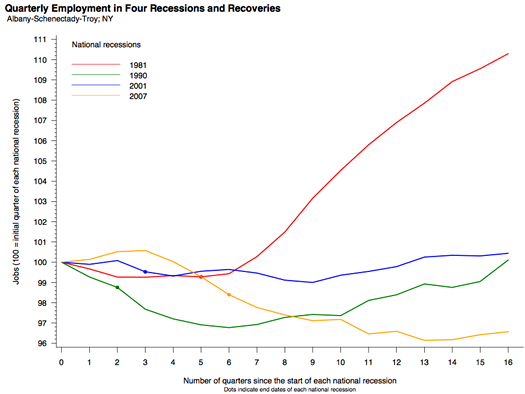
The yellow line is for the most recent recession. Yeah, not so great.
The Albany metro area is in the the second-weakest quintile for economic performance in the latest MetroMonitor report from Brookings Institution (tracking through December 2011).
That's not actually as bad as it sounds. In part, the report measure how well each metro has rebounded during the recession, and this area didn't fall that far compared to many other metro areas. For example: Detroit is among the top 20 metros in the report -- and we'd probably rather not trade with Detroit. (Also in the top 20: Austin. Foiled again!)
As it happens, the Albany metro area is doing pretty well in terms of housing prices (15th for change in housing prices from peak (2007Q1)) and "gross metropolitan product" (9th for change in GMP from peak (2007Q4)). It's not so hot for jobs -- the number of employed people here is only up .4 percent compared to the low point (2011Q1).
The graph above gives you some sense of how hard the recession has hit the local job market, compared to past recessions. We didn't get knocked down, but we're still just sort of staggering forward because whatever gains there have been (example: GlobalFoundries) have been blunted by losses (example: local school districts, governments).
The profile for the Albany metro -- with a bigger version of the graph -- is embedded after the jump.
Speaking of jobs: The state Department of Labor reported today that the Albany metro area had about 5,500 more job last month compared to February 2011.
graph: Brookings Institution
Earlier on AOA: This is a good place to find a job, Forbes says
Yep, gasoline prices have gone up
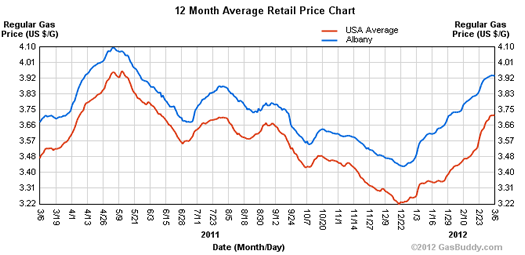
The blue line is the reported Albany area average price per gallon, the red the reported national average price.
Today's chart: From AlbanyGasPrices.com, it's a chart of Albany area gasoline prices over the last year.
In what's been painfully obvious if you've been filling up recently, there's a been a steep rise since December -- about 15 percent. But the recent run up follows what was more or less 8 months of declines. In fact, prices are still a bit below last year's high in April.
By the way: There are a handful of stations charging more than $4/gallon, according to AlbanyGasPrice.com's crowd-sourced reports -- including a station in Guilderland reportedly charging $4.16. The lowest price reported today in the core Capital Region was 3.83 in in Ballston Spa.
Taxes: The combined state and federal tax on a gallon of gasoline in New York State is 67.4 cents -- the highest in the nation. California and Connecticut are tied for #2 at 67 cents. [API]
[via @AndyArthur]
Earlier on AOA: March 2011: Everyone's taking a hit on gas prices -- sometimes even the gas stations
chart: AlbanyGasPrices.com
This is a good place to find a job, Forbes says
 External validation: Forbes says the Albany-Schenectady metro area is #4 on the mag's "Best Cities for Jobs" list. Forbes cites the GE battery plant and the GlobalFoundries fab as reasons for the metro's ranking.
External validation: Forbes says the Albany-Schenectady metro area is #4 on the mag's "Best Cities for Jobs" list. Forbes cites the GE battery plant and the GlobalFoundries fab as reasons for the metro's ranking.
Those are good reasons. And it's reasonable to be generally optimistic about the Capital Region economy -- the unemployment rate has been relatively mild compared to the rest of the country, and the housing market didn't implode like it did in other metros. There's the aforementioned factories, and all the nanotech stuff.
But it's also worth noting some context: there are currently fewer employed people here than five years ago -- about 14,000 fewer, if you compare December 2007 to December 2011, according to the federal Bureau of Labor Statistics (xls). And in December 2011, there were about 30,000 unemployed people in the region, according to the NYS Department of Labor.
Forbes says it developed its list by ranking "the 100 largest U.S. metropolitan areas by a variety of statistics including unemployment rate, household income and projected job growth," while screening out "cities that were merely rebounding from the recession." (Sorry, Las Vegas.)
Here are the top five from Forbes' list:
1. Washington, DC
2. Des Moines, Iowa
3. Poughkeepsie/Newburgh, New York
4. Albany-Schenectady, New York
5. Madison, Wisconsin
photo: GlobalFoundries
Capital Region rents
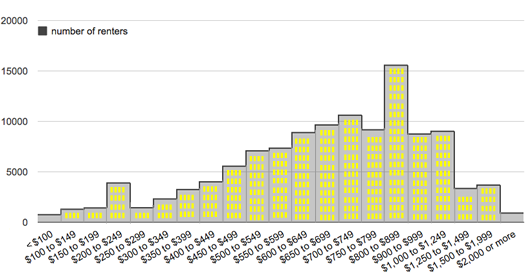
The distribution of rent prices in the Albany-Schenectady-Troy metro area in 2010, according to Census Bureau estimate. Here's a larger version.
After seeing that the Capital Region had one of the lowest apartment vacancy rates in the nation last year, we were curious about rents here -- how they're distributed and how they stack up against other metro areas. [Biz Review]
Bring on the charts and graphs...
Capital Region median home prices 2011
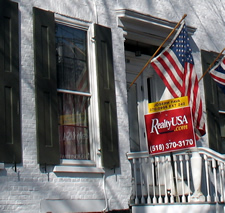 The median sale price of single family homes in the Capital Region was basically flat in 2011 compared to 2010, according to numbers from the Greater Capital Association of Realtors.
The median sale price of single family homes in the Capital Region was basically flat in 2011 compared to 2010, according to numbers from the Greater Capital Association of Realtors.
The median price for sale price for a home in the greater Capital Region was $186,032 in 2011. It was $203,511 in the Capital Region's four core counties. Both of those medians were down about 1 percent from 2010.
GCAR (as it's known) recently posted its annual market report for 2011. It includes stats for individual counties, cities, and towns in the Capital Region -- we've broken those out into a table after the jump.
While prices were basically flat for the region as a whole, the average time it took to sell a house increased. GCAR says the average number of days on the market until sale was 101 days in 2011, up from 92 in 2012. (For some perspective, the average was 79 days in 2007. It's been rising each year since.)
Onto the table...
Ecovative in Wired
 There's a profile of Green Island startup Ecovative in the February issue of Wired -- the article is now online via Wired UK (which explains the Britishisms in the linked story above).
There's a profile of Green Island startup Ecovative in the February issue of Wired -- the article is now online via Wired UK (which explains the Britishisms in the linked story above).
You've read some of it before, but there are some interesting new (to us) bits that touch on how good ideas come about, and what it takes to foster them. Also: Eben Bayer and Gavin McIntyre may be the first Wired profile subjects who grew their own headline.
We've posted a bunch about Ecovative, in part because it's an interesting local story with a fun angle (Packaging! Made from mushroom roots! By two good-looking nerdy guys!). But the company also has big potential. The polystyrene packaging business is a $20 billion a year industry (according to the Wired article) -- and Ecovative is looking to disrupt it with a product it says costs the same and doesn't harm the environment. That's an enormous opportunity. And it's growing from the ground up here.
Sure, it's not a multi-billion dollar chip fab or sprawling nanotech campus. But maybe it could be, someday. Upstate New York benefited greatly over the last century thanks to companies that created new industries -- names such as Kodak, Xerox and GE (many of which are now faded). If this part of the country ever finds that sort of prosperity again, it most likely will involve people and companies that have disruptive, industry-creating or shifting ideas.
Is it likely that Ecovative ever becomes as big as Kodak (once was) or GE? The odds are extraordinarily long. But all those companies started somewhere. Why not a warehouse in Green Island?
thumbnail: Chris Crisman / Wired
A neighborhood where (economically) everyone's just about the same
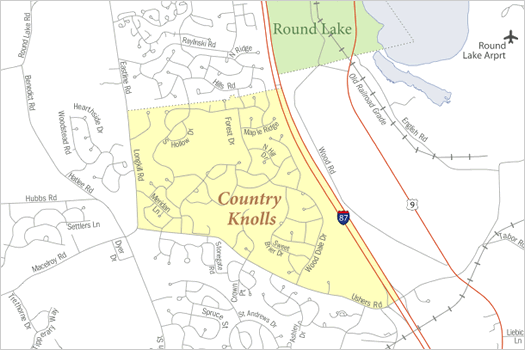
Almost none of these things are not like the others.
The Country Knolls neighborhood in Clifton Park has the smallest income inequality of any place in the nation, according to the Census Bureau (with a handful of statistical caveats). That is, there's very little distance between the high and low ends of the income distribution there (Gini index of 0.214). Or, to put it simply, almost everyone there has just about the same level of household income.
Notes the Census Bureau in the report, U.S. Neighborhood Income Inequality in the 2005-2009 Period:
Country Knolls CDP NY, part of the Albany Urbanized Area about halfway between Albany and Saratoga Springs NY (see Map 2), has the lowest measured income inequality (though not different from the others in the table because of the small sample sizes)--0.214, or 46 percent of the U.S. figure.21 In these small places with low inequality, sorting is likely the source of the homogeneity in income. For example, in Country Knolls in 2005-2009, 96 percent of the people were White non-Hispanic; 85 percent of households are married-couple households; 97 percent of the people at least 1 year old were living in the same residence 1 year earlier; 26 percent of people 25 years and over had a graduate or professional degree; the median income of households was $107,589; and only 9 of 609 housing units were renter-occupied (1.5 percent).
That median income would put a household somewhere close to the 80th percentile for income in the Capital Region.
A tip of the hat to the TU's Chris Churchill for noticing this. And The Biz Review talked about it with Clifton Park supervisor Phil Barrett, who lives in that neighborhood.
[via @MickIAm]
Earlier on AOA: Capital Region income distribution
map: US Census Bureau
Capital Region income distribution
 With all the talk about 99 percents and 1 percents, we were curious about the income distribution in the Capital Region.
With all the talk about 99 percents and 1 percents, we were curious about the income distribution in the Capital Region.
So, we looked up the data. Let's go to the charts, graphs, and discussion...
(You know you want to see where you rank.)
Friendly's files for bankruptcy, 6 Capital Region locations closing
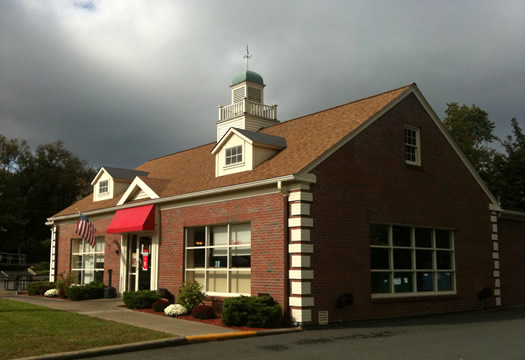
The Friendly's in Guilderland. Apparently those clouds were a portent.
Friendly's announced today that it's filed for bankruptcy (Chapter 11, the re-organization kind) -- and closing 63 "underperforming" locations, including six here in the Capital Region. [Friendly's press release]
The list of Capital Region closures is after the jump, as are the locations remaining. (It would appear this area was over Friendly'ed.)
Friendly's started in Springfield, Massachusetts in 1935. [Boston Globe]
Earlier on AOA: With bankruptcy on the horizon, Daniel ate the Buffalo chicken sliders at Friendly's
Bill Clinton's speech at the Empire State Plaza
After the announcement of the $4.4 billion big thing about small things, Bill Clinton spoke at the New York Open for Business conference Tuesday at the ESP. The video is embedded above. Clinton's speech starts at the 50:00 mark (you can just jump to that point).
At the beginning of the speech, Clinton gives a shoutout to Jerry Jennings and remembers... jogging in Albany.
$4.4 billion for chip fab research in the state, and more jobs at Albany NanoTech
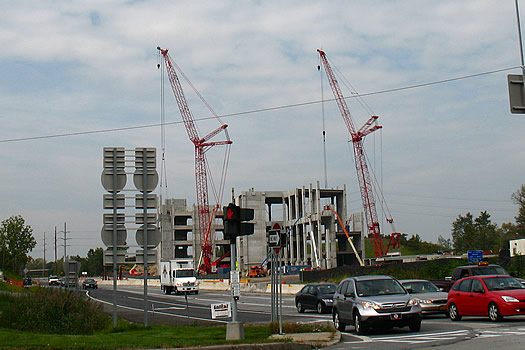
The construction at the Albany NanoTech expansion today.
Andrew Cuomo announced today that a consortium of tech companies will be investing $4.4 billion in chip fab research facilities around the state. The Cuomo admin says the research effort will create and/or retain 6,900 jobs -- 800 of them at UAlbany's College of Nanoscale Science and Engineering (CNSE) complex.
You'll recognize many of the names of the corporations involved: Intel, IBM, GLOBALFOUNDRIES, TSMC and Samsung. Said Cuomo this morning at the NY Open for Business conference at the ESP: "These companies could have gone anywhere on the globe ... they're investing right here in New York."
In addition to Albany NanoTech, there will also be investment at IBM in Fishkill, SUNYIT in Utica, and CNSE's facility in Canandaigua.
The state is putting $400 million toward this effort, which the Cuomo admin says will go directly to CNSE at UAlbany -- and all the tools and equipment will belong to the college.
The research will focus on making computer chips from 450 mm wafers. Current technology uses 300 mm wafers, and the larger size offers the potential of cheaper, faster chips. As an Intel exec told the audience today: "[450 mm] allows us to continue Moore's Law in an economic way."
That CSNE building going up at Washington and Fuller in Albany will house the facilities for this effort, and be called NanoFab West or NanoFab X. UAlbany has been coy about the purpose of that building, maybe because it was sitting on this announcement. It's also expected the expansion will house green energy research, including that $400something million solar panel research consortium. [TU CapCon] [TU Places and Spaces] [TU] [CSNE]
It's probably fair to say Cuomo was stoked this morning. As he crowed at one point during his remarks: "We won a very important competition globally. ... Why? Because we are New York. That's why we won it."
Albany metro an "economically vibrant college town"
 The Albany metro area ranks 15th in a list of the "most economically vibrant college towns" from The Atlantic and Richard Florida.
The Albany metro area ranks 15th in a list of the "most economically vibrant college towns" from The Atlantic and Richard Florida.
They applied the term "college town" somewhat loosely:
Our measure is not limited to smaller, more traditional college towns, but also includes larger metros like Boston, San Francisco, Washington D.C., and New York, which are home to major college campuses and large numbers of students and faculty. We measure economic vibrancy in terms of six key variables: per capita income, high-tech industry concentration, the rate of innovation (measured as patents per capita), human capital (the percentage of adults with a bachelor's degree or higher), percent of the workforce in the creative class, and the affordability of housing.
Boulder was #1 on the list. (Tangent: Should we start nurturing Boulder envy? Is Boulder the new Portland? The new Austin?)
(Thanks, Jess!)
Capital Region unemployment down a bit
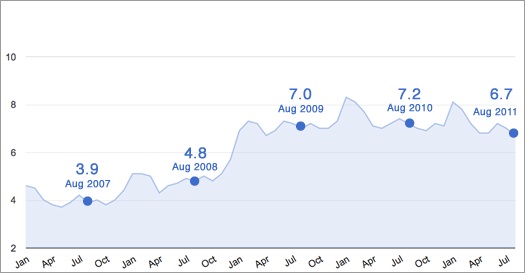
The last five Augusts. (see note below)
The Capital Region's unemployment rate was 6.7 percent in August, according to data out Tuesday from the state Department of Labor. That's down from 7.2 percent in August 2010, and 7 percent his past July. (August 2010 is the best comparison because the data is not seasonally adjusted.)
Even with the decline in unemployment rate, the Capital Region still had fewer people employed this past August compared to a year ago -- about 4,000 fewer people. There were just under 30,000 people unemployed in the Capital Region last month.
The chart above tracks the Capital Region's unemployment rate by month over the last five years, with each August marked.*
The state's unemployment rate was 7.7 percent, down from 8.3 percent in August 2010. The national unemployment rate was 9.1 percent.
Breakouts for local counties after the jump. Saratoga County had one of the lowest rates in the state.
New Yorkers: yeah, we've been better
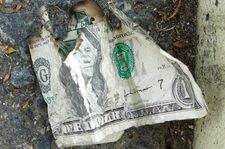 From a Siena poll out this week about New Yorkers and the economy:
From a Siena poll out this week about New Yorkers and the economy:
+ 42 percent of respondents said they were worse off financially now than they were last year. 16 percent said they were better off.
+ 50 percent said this statement matched their thinking about the economy: "Unfortunately, I think our country's best economic days are behind us. I'm afraid the next generation will have to accept a lower standard of living."
+ But 59 percent of people said they think the economy will be better in 10 years. (19 percent said it would be worse.)
More on jobs, expenses, and the "problem" with government...
The confidence is crumbling
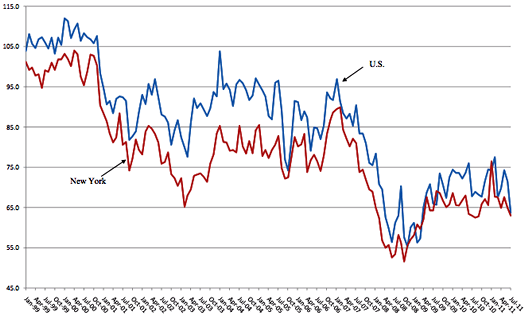
A chart of consumer confidence since 1999. The red line is New York State, the blue line is the nation.
Were you as spooked by the debt ceiling debacle as everyone else seems to have been? A new Consumer Confidence poll released today by the Siena Research Institute shows that people are feeling pretty down about the current state of the economy and even more bleak about the future. Siena polled the state as a whole and also separated out the numbers for upstate as compared to New York City. Across the state, consumer confidence has fallen by 1.9 percent. In the upstate area, it's fallen by 3.1 percent. And that's just the overall number. When confidence in the economic future is measured, the numbers get even worse, with upstate confidence falling by a whopping 8 percent.
This chart on Siena Institute's main page shows how precipitously consumer confidence has fallen in the country and state since 1999.
What are your thoughts on the current economy? Are you, your family and friends better off financially than you were a year ago? What do you expect your financial situation will be a year from now?
graph: Siena Research Institute
The Albany metro bounces. Theoretically.

The Northeast and Midwest: resilient.
The Albany metropolitan area ranks among the most "resilient" metros in the nation, according to rankings out this week from researchers at the University at Buffalo. The Albany metro ranked 48th out of 361 metros nationwide -- that's among the top 20 percent.
OK, so if you throw the Capital Region against a wall, it springs back? Sort of. Maybe.
SUNY's economic impact on the Capital District

Impact of a walk-through fountain: priceless.
The SUNY system has a $1.3 billion annual economic impact on the Capital District, according to an analysis done by Rockefeller Institute at UAlbany and the University at Buffalo Regional Institute. It figures the SUNY system has a $19.8 billion impact on the state as a whole.
Here's a handful of facts, figures and bits for the Capital District that we pulled out of the report, in a few cases matched up with outside data...
Capital Region unemployment rate drops
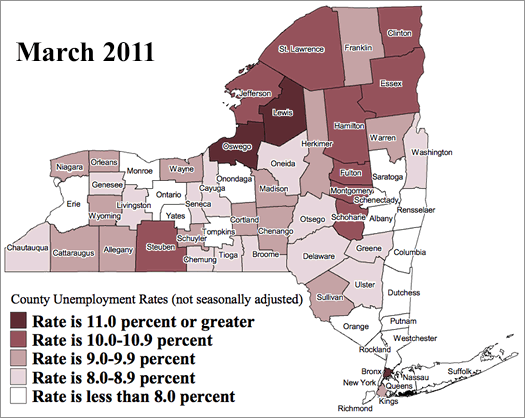
The Capital Region's unemployment rate was 7.2 percent last month, according to numbers out today from the state Department of Labor. That's down from 7.7 percent a year ago and 7.8 percent last month.
New York State's unemployment rate was 8 percent last month. That's down from 9.1 percent a year ago, and 8.7 last month. The national rate was 9.2 percent, down from 10.2 percent a year ago, and 9.5 percent last month.
Compared to the rest of the state, the Capital Region is doing relatively well. The Capital Region's rate was lower than all over metro areas in the state aside from Ithaca (5.4 percent) and the suburban counties around NYC (6.9 percent).
Zooming in a little more, individual Capital Region counties are doing even better compared to the rest of the state. Albany County's 6.8 percent rate was tied for sixth lowest in the state (with New York county). And Saratoga was right behind it at 6.9 percent. In fact, all four core counties of the Capital Region rank in the top 20 for lowest rates statewide. (The metro area's rate would be lower if not for Schoharie County, which the DOL includes in this metro, at 10.6).
There are still about 30,000 people in the Capital Region who are unemployed.
Numbers not seasonally adjusted, so the best comparison is to the same month a year ago.
Everyone's taking a hit on gas prices -- sometimes even the gas stations

A pump at the Stewart's at New Scotland and Whitehall in Albany on Tuesday.
Gary Dake, the president of Stewart's Shops, dropped a tweet last week that made us stop for a second:
Yesterday we sold 550,000 gallons of gas at an average margin of a 2 cent loss per gallon.
Yep, a regional chain -- with 271 gas station locations -- was selling gasoline last week at times for less money than it cost to buy and deliver it.
Curious about how that could happen, we called up Stewart's spokesman Tom Mailey for some background.
Job market takes a step back
The Capital Region's unemployment rate was 7 percent in November, according to the state Department of Labor. That's up from 6.7 percent in November 2009. The region is down about 3,000 jobs compared to a year ago.
There were more than 31,000 unemployed people in the Capital Region in November.
New York State's unemployment rate was 8.3 percent in November -- up from 8.2 percent in October and down from 8.9 percent in November 2009. The total job count in the state was down 300 last month.
The national unemployment rate was 9.8 percent last month -- up from 9.6 in October and 10 in November 2009.
Anecdotal, but... We feel like we got a small view into the job market via the hiring process for the associate editor job with AOA. It's been sobering.
We got a lot of applications. And a lot of those people have skills and experience. There just aren't that many opportunities out there right now.
All data from NYS DOL. Capital Region data are not seasonally adjusted, so it's best to compare the same month from different years. State level data is adjusted, so if you'd like to compare one month to the next, go for it.
Adding jobs one place, losing them another
New York State added more than 40,000 private sector jobs last month -- the biggest such increase since 2005, according to the state Department of Labor. Good news!
Here's the thing, though: the state lost 37,000 public sector jobs compared to the same month a year ago. The large majority of those jobs were at the local level. And with stimulus money drying up, you have to figure governments will keep cutting.
The Capital Region added 2,800 private sector jobs in October, compared to October 2009. But public sector losses put the overall change at -1,900. There are still roughly 30,000 unemployed people in this area.
Prices from a market where they're not advertised
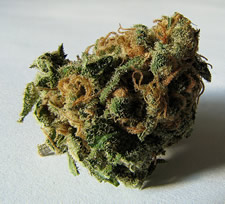 We're always curious about everyday patterns or odd markets that aren't necessarily easy to get a handle on. So we had to exclaim, "Dude!" when we recently came across a new site called Price of Weed.
We're always curious about everyday patterns or odd markets that aren't necessarily easy to get a handle on. So we had to exclaim, "Dude!" when we recently came across a new site called Price of Weed.
Yep. It's exactly what it sounds like. The site touts itself as "a global price index for marijuana." It relies on user submitted prices to compile a price index, broken down by state and quality. For example, here's the index for New York State. Here's an article about the anonymous creators.
The site includes reports by town. So, naturally, for journalistic purposes, we were immediately curious about prices in the Capital Region and how they compared to other parts of the state.
So we rolled the numbers.
Albany lures more money and nerds from Austin
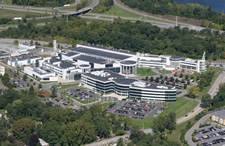 David Paterson and bunch of other top state officials were at Albany NanoTech today to announce that Sematech -- the semiconductor research consortium -- is moving another one of its arms from Austin to Albany. (This had been simmering for a while.) The move will reportedly bring 100 jobs and $100 million in investment ($20 million of that public). [Paterson admin] [TU]
David Paterson and bunch of other top state officials were at Albany NanoTech today to announce that Sematech -- the semiconductor research consortium -- is moving another one of its arms from Austin to Albany. (This had been simmering for a while.) The move will reportedly bring 100 jobs and $100 million in investment ($20 million of that public). [Paterson admin] [TU]
When the transition is complete, Sematech will have moved all of its operations from Austin to Albany. Put that in your breakfast taco.
While the jobs and the investment would be nice on their own, the hope is that this sort of project will spur related development here. For (a big) example, GlobalFoundries was attracted to this area by the semiconductor research center at UAlbany. And then that related development attracts its own related development and so on and so on and eventually there's a cluster. And then Austin will start looking to us for inspiration. (OK, maybe not that last part. Yet.)
All together, there's now been more than $6.5 billion worth of investment at Albany NanoTech.
photo via Albany NanoTech
Capital Region unemployment rate stuck

The dots mark the last five Augusts.
The Capital Region's unemployment rate was 6.8 percent in August, according to the state Department of Labor. It was 6.9 percent in July and 6.8 percent in August 2009. (August to August is the best comparison because the local unemployment rate is not seasonally adjusted.)
There are more than 31,000 people unemployed in the Capital Region.
New York State's overall unemployment rate in August was 8.2. It was 8.4 in July and 8.6 in August 2009 (seasonally adjusted, so if you'd like to compare different months against each other, compare away).
The situation isn't good here, but it's better than the nation as a whole. The national unemployment rate in August was 9.5 percent -- about the same as a year ago.
Breakouts for individual Capital Region counties after the jump.
Related: The US Census Bureau released numbers of on the poverty rate today. It estimates New York State's rate in 2009 at almost 16 percent. That national poverty rate was 14.3 percent -- the highest since 1994.
Consumer "non-confidence"
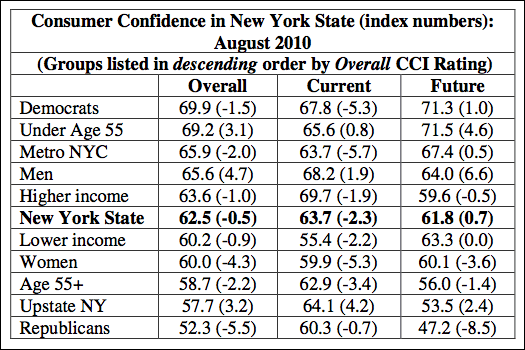
The higher the number, the more confident.
Check out this table from the Siena Research Institute's monthly New York State consumer confidence index.
Look at the split between Democrats and Republicans for confidence about the future of the economy. There's also a relatively wide split between upstate and NYC.
From SRI director Doug Lonnstrom:
Statewide our numbers are weak and depict worried consumers very reluctant to spend. Under the hood, we see Democrats saying the economic glass is nearly half full, but Republicans, 25 future index points lower, are now more pessimistic about their own prospects as well as the five-year state outlook than they have been since we began measuring consumer confidence in 1999. Over six of every ten Republicans expect poor business conditions in New York this year and widespread unemployment through 2015. Democrats forecast a somewhat rosier picture for the state and are much more likely than Republicans to insist that somehow, someway, they personally will be better off in a year.
As NYT reported earlier this week, New York City has fared relatively well during the recession (relative being the key word) -- and things are looking up there. That might explain some of the split -- both political and geographic.
Earlier on AOA: Optimism for the Capital Region housing market
table: Siena Research Institute
The Albany metro area is "brainy"

And as we all know, smart is sexy.
The Albany metro area is #13 on a list of the "20 Brainiest Cities in America" compiled by Richard "Creative Class" Florida (and another researcher) for the Daily Beast.
From the accompanying article:
Brainy metros tend to have higher incomes, wages, and economic output, higher levels of innovation (measured as patents), more high-tech industry, and higher housing prices, according to an analysis by my research team at the Martin Prosperity Institute. They have also been among the most resilient during the current economic downturn.
And the methodology:
The Brainiest Metros Index is based on three variables: (1) the share of adults 25 years of age and older with a Ph.D., master's or professional degree (from the U.S. Census American Community Survey), (2) computer scientists and mathematicians as a share of all employment, and (3) scientists (physical, biological, social) as a share of total metro employment (both from Bureau of Labor Statistics). The index weights all three variables equally and covers 362 U.S. metro regions.
Boulder, Colorado was #1.
(Thanks, Carl!)
Earlier on AOA:
+ Albany: not dead, yet
+ Listomania
The Radix Ecological Sustainability Center
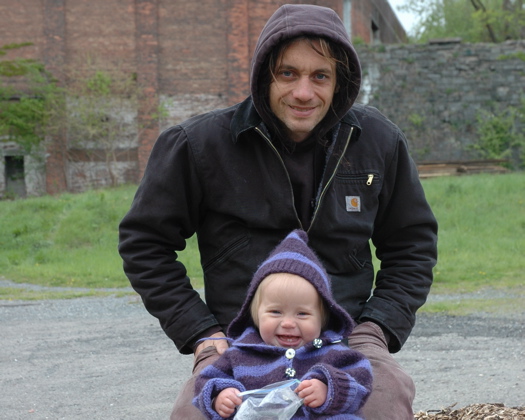
Scott Kellogg and his daughter on the site of the future Radix Center.
Scott Kellogg wants to teach you to live greener and be more self-sustaining -- you know, grow your own food, raise a little livestock.
Hey, city dwellers -- this means you.
Kellogg and Stacy Pettigrew are the founders of the Rhizome Collective, a center for community organizing and urban sustainability in Austin Texas, and the authors of The Toolbox for Sustainable City Living.
Now they live in Albany, and they're building a space called The Radix Center to teach city dwellers and suburbanites alike to do everything from compost with worms and grow porch mushrooms, to collect rainwater and raise their own fish.
Scott says not only is this possible, you're actually going to enjoy it.
Not dead yet

Going on more than three centuries.
This whole "Albany is a dead city" thing just seems silly to us. Albany isn't dead. Unless this is some sort of Sixth Sense situation. Or maybe we're all zombies -- and Albany is actually an undead city. (What's for lunch? Braiiinnns...)
But, whatever... let's kick this around a little bit.
The local housing market is... something
Median sale prices. Just a reminder: it's one month of data, so take it with a grain of salt.
The number of closed home sales was down 38 percent in July compared the same period last year, according to Greater Capital Association of Realtors.* But get this: the median sale price was up five percent -- to $199,000 (year to date prices are up slightly, too).
The steep drop in the number of sales probably is a result of the federal tax credit that ended earlier this year -- a lot of house buying was probably crammed in before the deadline.
There are still a lot of houses out there, though. GCAR reports the market has 12.5 "months supply of inventory." And the number of days on the market for the average house is 86 -- that's up about five percent over last year.
By the way: If you already own a house -- and think you'll be there for at least a few years -- it might be a good idea to look a refinancing. Rates are extraordinarily low right (you can get a 15 year mortgage for around 4 percent). Refinancing could save you a lot of money in the long run (even with New York's high closing costs).
New York has the highest closing costs
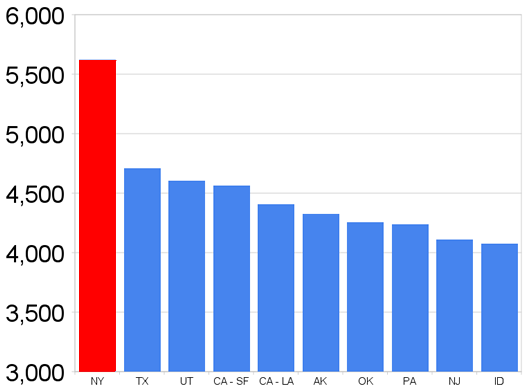
The ten most expensive states (counting LA and SF separately). Arkansas had the lowest average costs at a little more than $3,000.
The closing costs for a $200,000 loan in New York State average $5,623, according to a survey by Bankrate. That's highest in the nation. (Yes, shock. This is New York.)
New York's average is way ahead of #2 Texas (yeah, not everything is bigger in Texas). The Lone Star State's average was $4,708 -- 16 percent less than the Empire State. In fact, New York's total was 50 percent higher than the national average. (Arkansas had the lowest at $3,007.)
Here's how Bankrate figures the costs break down in New York.
Of course, closing costs make it more expensive to buy a house -- but they also add to the price of refinancing your mortgage. And right now mortgage interest rates are at record lows. (Here are some tips for saving on refinance closing costs.)
[via Business Buzz]
graph based on figures from Bankrate
Optimism for the Capital Region housing market
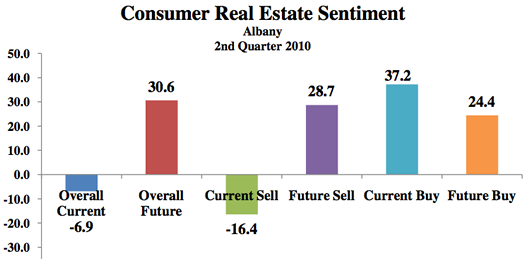
positive = optimism | negative = pessimism
People in the Capital Region are optimistic about the housing market here, according to a Siena Research Institute report out this week. In fact, people are more optimistic about the housing market here over the next year than in any other part of the state.
Also, SRI reports that sentiment here is strongly leaning toward this being a buyer's market right now. That's not really surprising. The median sales price for single family homes in the Capital Region is now about the same as it was five years ago, according to the Greater Capital Region Association of Realtors. And while the "months supply of inventory" has been down recently, it's still relatively high compared to the last five years.
The strong optimism for the future is a little harder to figure. Is it a result of GlobalFoundries? Or maybe a byproduct of the fact the housing market here never really went in the tank like it did other places?
A quick explanation of the graph above: SRI surveyed more than 2,000 people to derive the "consumer real estate sentiment scores." Positive numbers indicate optimism, negative numbers pessimism. Zero is the point at which there's an equal amount of optimism and pessimism. SRI says anything beyond 50 (+ or -) is considered "both rare and extreme." (There's more detailed explanation at that first link.)
Earlier on AOA:
+ The slow climb toward economic recovery
+ Capital Region June unemployment rate better than last year
graph: Siena Research Institute
The slow climb toward economic recovery

Every week there seems to be some story about how a local county or other municipality (or, well, the state itself) is scraping for cash. The chart above, from the state comptroller's office, might shed some light on why.
The chart tracks sales tax collections for counties outside NYC over the last five years. As you can see, revenues are headed back up again -- but they're still only at the March 2007 level.
The comptroller's office reports that county sales tax collections outside NYC grew 3.7 percent during the first half of 2010 (they were down 6.9 percent during the first half of 2009). But collections in the Capital District were "essentially flat." Saratoga County did well -- its collections were up more than five percent. Albany, Schenectady and Rensselaer counties were all flat or down a bit, though.
Earlier on AOA: Capital Region June unemployment rate better than last year
chart: NYS Comptroller's Office
Capital Region June unemployment rate better than last year
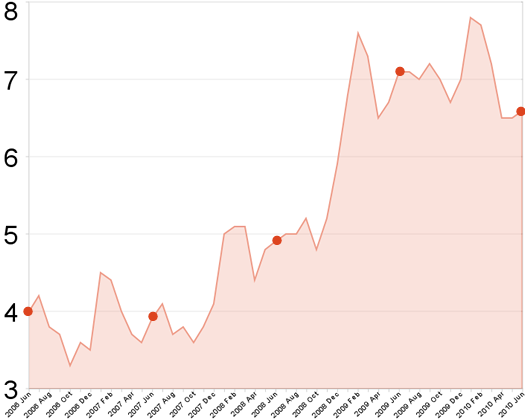
The dots mark the unemployment rate for the last five Junes.
The Capital Region's unemployment rate was 6.6 percent in June, according to the state Department of Labor. It was 6.5 percent in May and 7.1 percent in June 2009. (June to June is the best comparison because the local unemployment rate is not seasonally adjusted.)
There are more than 30,000 people unemployed in the Capital Region.
New York State's overall unemployment rate in June was 8.2. The state's rate was 8.3 in May and 8.6 in June 2009 (seasonally adjusted, so if you'd like to compare different months against each other, compare away).
The national unemployment rate in June was 9.5 percent.
Breakouts for individual Capital Region counties after the jump. Every county showed a decrease in the unemployment rate compared to June 2009.
The Capital Region's economy is performing relatively well
 The Albany metro area was among the 21 economically strongest performing large metro areas through the first quarter of 2010, according to the Brookings Institution.
The Albany metro area was among the 21 economically strongest performing large metro areas through the first quarter of 2010, according to the Brookings Institution.
The report bases the rankings on a handful of categories: employment, unemployment, output, home prices, and foreclosure rates.
The Albany metro area scored well for foreclosed properties and both employment and unemployment -- and relatively well for housing prices (the ranks, with the associated data, are after the jump).
Of course, all these rankings are relative to other metro areas. The overall picture is not great. The Brookings report describes the current national situation as "a jobless and increasingly fragile recovery."
The Morrissey Club: a chamber for the "creative class"
 Bob Millis thinks the Capital Region's musicians, artists and inventors have a lot in common. He also believes they can do a lot to help each other.
Bob Millis thinks the Capital Region's musicians, artists and inventors have a lot in common. He also believes they can do a lot to help each other.
Millis, a business strategy consultant who blogs about technology, business, economics, community and other stuff, is also one of the founders of The Morrissey Club -- a sort of chamber of commerce alternative for the creative class of the Capital Region.
You can check the group out tomorrow when they team up with Sustainable Saratoga to host a panel discussion with James Kunstler and others at Skidmore.
Millis talked with AOA about the group, who it's for and why the Capital Region needs it.
The Capital Region's unemployment rate is a little better. Sort of. Maybe.

The dots mark the Capital Region unemployment rate for each May since 2000. It's easier to read big.
The Capital Region's unemployment rate was 6.5 percent in May, according to the state Department of Labor. It was 6.5 percent in April and 6.7 percent in May 2009. (May to May is the best comparison because the local unemployment rate is not seasonally adjusted.)
The labor department reports the number of non-farm jobs in the Capital Region last month was down 2,500 compared to May 2009. There are still almost 30,000 people unemployed in the Capital Region.
New York State's overall unemployment rate in May was 8.3 -- the lowest rate since April 2009. The state's rate was 8.4 this past April and 8.4 in May 2009 (seasonally adjusted). But the labor department says the number of non-farm jobs in the state last month was down 22,700 compared to May 2009.
So, what's up here? There are fewer jobs compared to this time year -- but the unemployment rate is down (slightly)?
The benefit -- and cost -- of living here
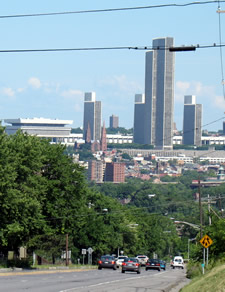 The Albany metro area ranked #18 for quality of life in an analysis by Portfolio.com of the nation's 67 biggest metros.
The Albany metro area ranked #18 for quality of life in an analysis by Portfolio.com of the nation's 67 biggest metros.
Albany was just behind San Francisco and just ahead of Worcester. Raleigh was #1.
The metros were ranked on 20 criteria. Most of the categories are economic indicators such as household income -- but the set also includes categories such as commuting time and new home stock. Albany scored very well for jobless rate (3rd) and commuting time (7th). (The numbers were pulled from 2006-2008 Census Bureau figures, so many have probably since changed.)
The selection of categories highlights how tricky it is to figure something like "quality of life." Sure, people are probably happier when they have a short commute and don't have to scrape to pay the mortgage. But stats like that don't necessarily catch other important elements -- like weather, cultural opportunities or restaurant quality.
Cost of living: a coalition of local development groups has posted a cost of living calculator that compares other metro areas to the Capital Region. The calculator provides an overall cost comparison -- and it also breaks out individual items.
[via @techvalleyny]
Earlier on AOA: Misconceptions about Albany?
New York continues to add jobs
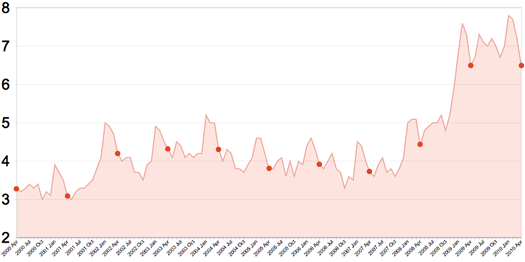
The dots mark the unemployment rate for each April since 2000. It's easier to read large.
The Capital Region's unemployment rate was 6.5 percent in April, according to the state Department of Labor. It was 7.2 percent in March and 6.5 percent in April 2009. (April to April is the best comparison because the local unemployment rate is not seasonally adjusted.)
The labor department reports the Capital Region added more than 4,000 jobs last month. There were almost 30,000 people unemployed in the Capital Region.
New York State's overall unemployment rate was 8.4 -- that's lowest rate since May 2009. The state's rate was 8.6 in March and 8.1 in April 2009 (seasonally adjusted). The labor department says the state added jobs for the fourth straight month.
That unemployment rate for the entire United States was 9.9 percent in April.
Breakouts for individual Capital Region counties are after the jump.
At the pump
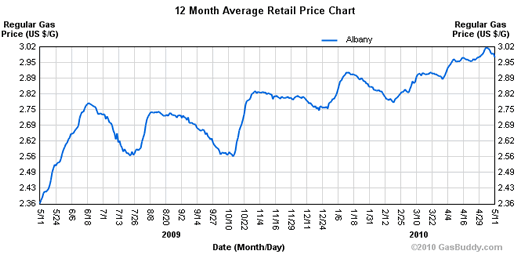
The chart above is from AlbanyGasPrices.com, the crowd-sourced gas prices site. It tracks the average price for a gallon of regular gasoline in the Albany area over the past year. The price has backed off during the last week or so, but it's still just about at the high for the last year.
If you go to the Albany Gas Prices site, you can graph the price against the national average (it tracks pretty closely) and crude oil prices -- and over different time spans, too.
AAA also tracks this data for the metro area, but without the graphs (and who doesn't love a graph).
The federal Energy Information Administration forecasted today that average gasoline prices will increase about four percent over the next year.
[prompted by a tweet from @AndyArthur]
Earlier on AOA:
+ From 2008: Gas hits four dollars and everyone's squeezed
+ How many gallons per mile?
+ Save money on gas... at Price Chopper?
graph: Albany Gas Prices
Pay gap smaller in New York, but still wide
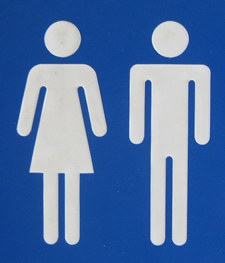 New York State ranks #6 in the nation for having the smallest pay gap between male and female workers. But women here still only make 78 percent of what men do, according to AAUW.*
New York State ranks #6 in the nation for having the smallest pay gap between male and female workers. But women here still only make 78 percent of what men do, according to AAUW.*
Wyoming has the smallest gap (women make 89 percent as much as men there). Alaska has the biggest (women at 64 percent). Nationally, women make 71 percent as much as men.
A 2007 analysis by two researchers at AAUW reports that even when controlling for factors such as experience (including work hours), training, education, and personal characteristics, men still make five percent more than women.
The Harvard Business Review has a whole section dedicated to pay gap issues this month. This article about "delusions of progress" for women in management was particularly interesting.
*That's for "median earnings for ... male and female full-time, year-round college-educated workers, ages 25 and older." The gap is smaller -- and New York ranks one spot better -- for "median earnings for ... male and female full-time, year-round workers, ages 16 and older, all educational levels." The data are from the Census Bureau's 2008 American Community Survey.
[via @SenGillibrand and @NMessier]
Earlier on AOA: RPI's Shirley Ann Jackson tops compensation chart
photo: Flickr user sylvar
A few more jobs
The Capital Region's unemployment rate was 7.2 percent last month, according to numbers out from the state Department of Labor today. That's down a bit from February (7.7 percent) and about the same as March of 2009 (7.1 percent). The labor department figures the area added 2,700 jobs last month -- but it's still 6,700 jobs behind where it was in March 2009.
There are almost 33,000 unemployed people in the Capital Region.
A county-by-county breakdown is after the jump. As you'll see, Albany and Saratoga counties aren't doing all that badly (relatively). Schoharie County, which the DOL includes in the Capital Region, is hurting.
New York State's unemployment rate was 8.8 in March (9.2 in February | 8.2 in March 2009). The national unemployment rate was 10.2 (10.4 in February | 9.0 in March 2009).
Numbers for the Capital Region are not seasonally adjusted (so the best comparison is the month from the year before). State and national numbers are seasonally adjusted.
The new SUNY strategic plan
SUNY released the outline of its new strategic plan today (here's the flip-through brochure). Overall, the plan aims to set up SUNY to "drive New York's economy" and revitalize communities. It includes six "big ideas":
 + A focus on entrepreneurialism, including mentoring and support for startups.
+ A focus on entrepreneurialism, including mentoring and support for startups.
+ A "cradle to career" education pipeline. Initiatives include an effort to reduce new teacher attrition and more co-op jobs.
+ Focus on health care -- research and jobs.
+ Renewable energy technology
+ Increasing presence in local communities. Among the initiatives for this focus: more student volunteer work and "study abroad" opportunities within the state (well, Long Island is sort of like its own country).
Step one for the plan apparently was branding the university system to look like a biotech company (brochure cover on the right).
SUNY has 64 campuses and almost 465,000 students. About 18,000 of those students are at UAlbany.
Patented
 There were 203 patents issued to companies/people in the Capital Region during the first quarter of this year, according to local IP law firm Hoffman Warnick (84 were issued to GE). That's up almost 8 percent from the same quarter a year ago, and about flat from the quarter before. (Patent totals often get touted as signs of innovation and economic vitality, but doubts about that view have been gaining attention.)
There were 203 patents issued to companies/people in the Capital Region during the first quarter of this year, according to local IP law firm Hoffman Warnick (84 were issued to GE). That's up almost 8 percent from the same quarter a year ago, and about flat from the quarter before. (Patent totals often get touted as signs of innovation and economic vitality, but doubts about that view have been gaining attention.)
Among the Capital Region patents: a Schenectady company was a issued a patent for locking box lid flaps (image to the right).
[via @erikimorton]
Not any worse
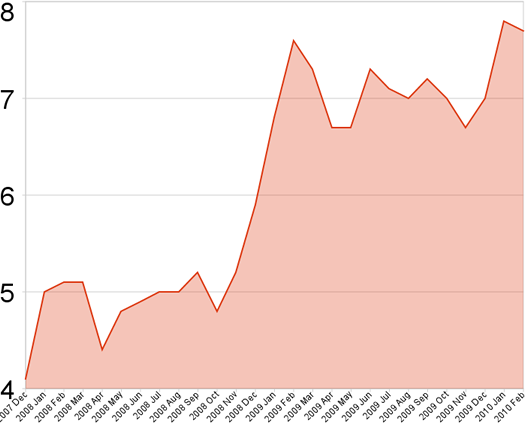
It's something.
What now counts as good news: the Capital Region's unemployment rate didn't get any worse last month.
The state Department of Labor reported today that the area's unemployment rate was 7.7 percent in February. It was 7.8 percent in January and 7.2 percent a year ago. *
The labor department figures there were about 4,700 more jobs in the Capital Region last month, compared to January. That's down almost 10k jobs from February 2009.
There were more than 35,000 unemployed people in the Capital Region last month.
Statewide, the unemployment rate was 8.8 percent (7.8 percent outside NYC). That's the same as January. It was 7.5 percent in February 2009. The national unemployment rate was 9.7 percent. **
A labor department official noted in the press release accompanying the numbers that "following previous recessions, it has taken the state about five years, on average, to regain all of the jobs lost during a downturn."
A county-by-county breakdown for the Capital Region is after the jump.
Also: For a different angle on the unemployment situation, here's tcrpmg's recent experience at a few job fairs.
The wrong way
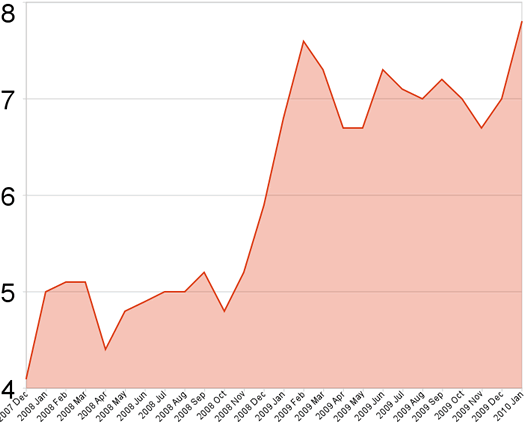
The Capital Region's unemployment rate since the start of the recession.
The state Department of Labor reported today that Capital Region's unemployment rate was 7.8 percent last month -- that's up from 6.9 percent in December, and 6.8 percent in January 2009.*
The raw numbers of unemployment send it home for us, though: more than 35,000 in the Capital Region were counted as unemployed last month.
The labor department also released its revised numbers for all of 2009. It reports that the average number of the jobs in the Capital Region declined 2.6 percent last year compared to 2008 -- that was one of the smallest drops in the state.
Statewide, the labor department reports that the average unemployment rate was 8.4 percent last year -- the highest mark since 1992. For January 2010, the state's unemployment rate was 8.8 percent -- compared to 8.9 percent in December and 7.1 percent in January 2009.**
The county-by-county breakdown for the Capital Region is after the jump.
* not seasonally adjusted
** seasonally adjusted
Median homes prices for January
Prices by county
Here are the median home sales prices for the Capital Region in January, as reported by the Greater Capital Association of Realtors.
Interestingly, or maybe oddly or maybe coincidentally, the average number days on the market was down in every county -- except Saratoga, which also registered the highest jump in median price. (Monthly numbers should be taken with a grain or two of salt -- especially in January, when a few sales one or way the other can shift a small pool of sales.)
GCAR's CEO notes in a press release that homes on the lower end of the price spectrum continue to sell more quickly than homes on the higher end, perhaps because of the first-time homebuyer tax credit.
Earlier on AOA:
+ Median home prices by city for 2010
+ Our housing market is overvalued?
Our housing market is overvalued?
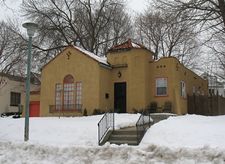 Via Kim M comes a follow up of sorts to this week's post about median home prices in the Capital Region. An analysis for CNN Money figures that the Albany market's home prices are "overvalued" by five percent. (Only 89 of 299 markets surveyed were figured to be overvalued.)
Via Kim M comes a follow up of sorts to this week's post about median home prices in the Capital Region. An analysis for CNN Money figures that the Albany market's home prices are "overvalued" by five percent. (Only 89 of 299 markets surveyed were figured to be overvalued.)
The same methodology was used to conclude that the market here was overvalued by 19 percent in 2006. The sale price in the Capital then was $189,900, according to GCAR. The median sale price at the end of 2009 was $192,500. (It would appear that GCAR and CNN Money are using different definitions for this market. CNN Money has the median price for this area pegged at 198,900.)
By the way: the Capital Region had one of the nation's lowest rates of home foreclosure in 2009.
Earlier on AOA:
+ Lots of houses
+ What's the price of a little extra style?
Median home prices by city

Median home prices for the Capital Region, by year (stats from GCAR)
The Greater Capital Association of Realtors (GCAR, to its friends) recently started including breakdowns of home sales data by city in its monthly stats release. GCAR released the December numbers yesterday, so there's now data for all of 2009. We thought it'd be interesting to see how the median home prices in various cities and towns in the Capital Region stacked up for the year.
You might surprised by which city's median price increased the most. (Yep, there actually were a few increases.)
Capital Region unemployment rate up
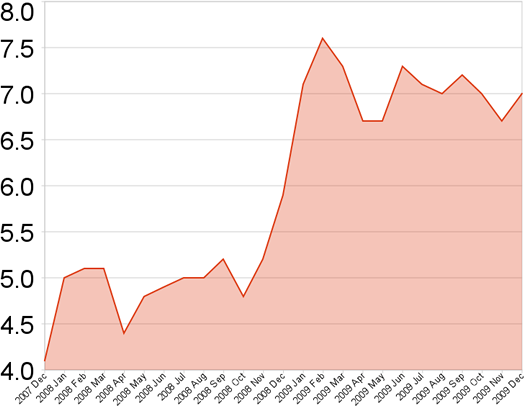
The Capital Region's unemployment rate since the start of the recession.
The Capital Region's unemployment rate was 7 percent in December, according to the state Department of Labor. That's up from 6.7 percent in November -- and 5.9 percent in December 2008 (that's the best comparison because the numbers are seasonally adjusted).
The number that strikes us about the unemployment data is the raw total: more than 31,000 people are unemployed in the Capital Region.
The labor department includes Schoharie County in the Capital Region rate, which probably skews things a bit. Schoharie's unemployment rate was pegged at 9.2 percent in December. The county-by-county breakdown is after the jump.
The state's overall unemployment rate was 8.8 percent in December, up from 8.4 percent the month before and 6.8 percent a year ago.
State unemployment rate corrected Friday morning.
Lots of houses

The Capital Region's supply of homes for sale, as measured by "months of inventory."
We were skimming through the latest package of Capital Region home sales stats from the Greater Capital Association of Realtors when the above graph caught our eye. It depicts the trend in "inventory" in the Capital Region.
Turning of the tide?
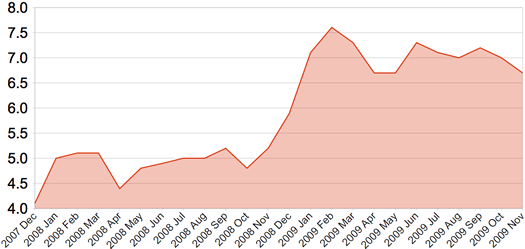
The Capital Region unemployment rate since the start of the recession.
The New York State Department of Labor today reported that the Capital Region's unemployment rate was 6.7 percent in November, down .3 percent compared to October. The rate was 5.3 percent in November 2008.*
The number that caught our eye this month was the raw number of people employed. The labor department reports that 419,900 people were employed in the Capital Region in November -- that's almost 11,000 fewer people with jobs than a year ago.
The state unemployment rate was 8.4 percent in November, down .3 percent from October (it was 6.1 percent in November 2008.) The national unemployment rate was 9.4 percent - down .1 percent from October (it was 6.5 percent a year ago).
* Capital Region data is not seasonally adjusted.
Sideways
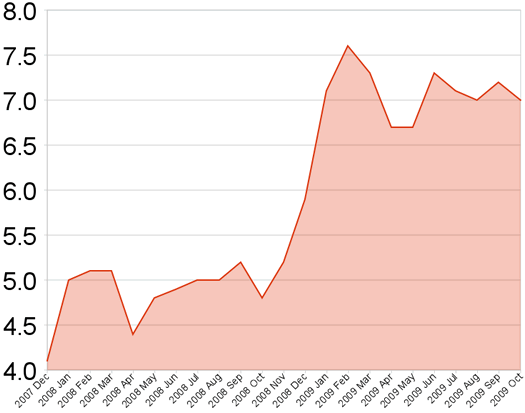
The Capital Region's unemployment rate since the start of the recession.
The Capital Region's unemployment rate was 7 percent in October, according to NYS Department of Labor data released today. That's up from 4.9 percent during the same period last year. It's basically unchanged from last month.
The labor department reports that the number of nonfarm jobs has decreased by 12,100 (2.7 percent) and the number of private sector jobs has decreased by 9,200 (2.7 percent) in the region over the last year.
The Capital Region is still doing better than both the state and country as a whole. The overall unemployment rate for New York State was 9 percent in October (8 percent everywhere except NYC) and 10.2 percent for the US.
We've updated our 10-year graph of Capital Region unemployment -- it really gives you perspective on how unusual the current labor market is.
The federal government reported last month that the national economy has begun growing again (well, GDP has).
Job growth often lags GDP growth, though. During the last national recession, the Capital Region's unemployment rate didn't start falling until three months after the recession ended. The state labor department reported that NYS lost 15,300 non-farm jobs last month.
Stimulating statistics
New York State released a breakdown this week of federal stimulus funding per county. (The state has gotten $18 billion in stimulus money.) The state breakdown (xls) also includes how much money has gone to education, Medicaid, infrastructure, etc.
We thought it would be interesting to see how the slices for each of the four core counties of Capital Region compare per capita and per square mile.
| County | Total | Per Person | Per Sq Mile |
| Albany | $303.1 million | $1,048 | $579,541 |
| Rensselaer | $103.3 million | $665 | $158,436 |
| Saratoga | $89.8 million | $414 | $110,988 |
| Schenectady | $150.9 million | $997 | $739,706 |
We got population and area numbers from the US Census Bureau (the populations were from 2008 estimates). Numbers have been rounded.
After the jump, all the New York counties (plus NYC) ranked by federal stimulus funding per capita. Saratoga County is close to the bottom.
Capital Region job market still scuffling
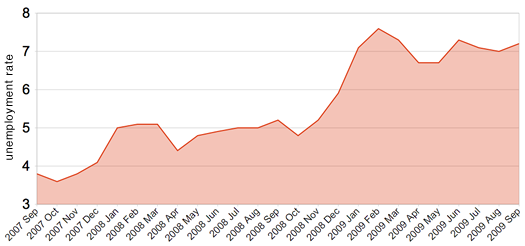
The last two years.
The Capital Region's unemployment rate was 7.2 percent last month, according to the state Department of Labor. That's up .2 percent from August -- and 2.1 percent from September 2008.
It's still better than both the state and the nation. The state's seasonally adjusted unemployment rate was 8.9 percent in September -- the same as August. The national rate was at 9.8 percent last month.
Earlier on AOA: A chart putting the Capital Region unemployment rate in a 10 year context (not good)
Chart data for the last two months from the NYS Department of Labor. Data for the other months is from the federal Bureau of Labor Statistics. The numbers are not seasonally adjusted.
Where the federal recovery money is going
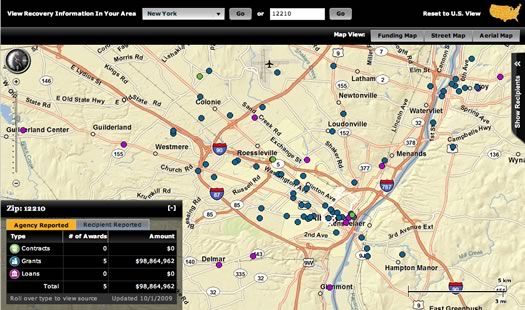
A screengrab from the Recovery.gov
Check it out: Recovery.gov -- the federal government's web site for "providing easy access to data related to Recovery Act spending" -- has a map function that lets you see where stimulus money is going locally.
As it happens, recovery money has ended up in a lot of spots in the Capital Region. Some of the places you'd probably expect -- some you might not. A few examples from dots on the map:
- HVCC - $3.3 million in grants through the Department of Education
- Web development firm Twin Technologies - a $700,000 loan from the Small Business Administration as part of a program that provides small businesses with financing they couldn't obtain in the private marketplace.
- Arizona Pizza in Clifton Park - a $950,000 loan from that same SBA program.
New York State's reported recovery money total is now more than $13 billion, according to the site.
(Thanks, Stephen!)
screengrab: Recovery.gov
Strong thunderstorm sweeps through area, unemployment rate highest in more than two decades, Cheerio Paterson is a biter, his name really is Harry Potter
The severe thunderstorm that swept through the area yesterday evening dropped hail and more than half an inch of rain very quickly. More than 40,000 National Grid customers lost power -- many of them in Saratoga County. The power at Crossgates was also knocked out for a few hours. There was flash flooding in Schenectady County (photos). Some of the hail in Albany County was 1.75 inches in diameter. [TU] [Daily Gazette] [Saratogian] [WNYT] [CapNews9] [kmg] [@tcrpmg]
The Capital Region's unemployment rate hit 7.4 percent in June, according to the state Department of Labor -- that's up from 4.8 percent during the same period a year ago. An analyst with the labor department that could be the highest local rate since 1977. The two job categories that took the biggest hits were government and construction. [NYS DoL] [TU] [Daily Gazette]
Shawn Morris dropped out of the Albany mayoral race yesterday. She said in a press released that she didn't think it was possible to beat Jerry Jennings in a three-way race (the other person being Corey Ellis). Morris told the TU no deal had been made between her and the Ellis campaign. [AOA] [TU]
The bill that would allow the City of Albany to create a residential parking permit system near the state capitol was set aside in the state Senate after not enough Democrats were present to push it through. The bill has already passed in the Assembly. [TU]
Cheap and good?

Who you calling cheap?
Forbes has ranked the Albany metro area the sixth best among "cheap cities."
So, hey, good for the Capital Region. And we agree that are a lot good things about living here. But we're not so sure about the "cheap" designation...
State Senate frozen with no end in sight, local orgs lack pandemic plans, abandoned high-end homes in Saratoga, DEC hoping for hot turtle action
The state Senate is basically frozen right now. Yesterday a judge dismissed the Democrats' suit seeking to void last week's takeover by the Republicans + Pedro Espada. The Republicans claimed victory and tried to go into session -- but with only 31 senators present, they couldn't form a quorum. [NYT] [Daily Politics]
David Paterson again called on the Senate to work out some sort of power sharing deal, perhaps bringing someone such as former chief judge Judith Kaye to preside over the chamber. He also said the line of succession to the governorship is in dispute. [TU]
If the state Senate ever does back into session, Espada is arguing that he should have two votes -- his regular vote plus one as acting lieutenant governor. Apparently there's no precedent for that, though. [NYP]
By the way: the Assembly has been working while all this has been going on. [Daily Politics]
Closing the book on Hodge Podge
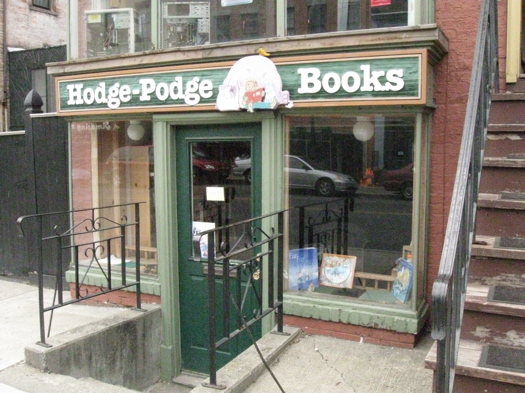
The home of Hodge Podge books. At least until June 30th.
So when we heard the other day that Hodge Podge Books, the children's/young adult book shop on Lark Street was closing after 27 years, we thought "Ohhhh. It's like The Shop Around The Corner in that Meg Ryan movie. It's kind of sad."
And it is sad.
But just a little bit.
Police say Saratoga Winners fire was arson, earthquake near Berne, two men Cheney'd while hunting turkey, time capsule found
Colonie police say the owner of Saratoga Winners set the club on fire so he could collect the insurance money. The owner is a former gynecologist -- his medical license was revoked 2006. [Troy Record] [TU]
The USGS reports there was a magnitude 3 earthquake near Berne last night -- people report that it woke them up. [USGS] [CBS6]
Stillwater says water usage in the town is down 2 million gallons (no time frame given)-- perhaps out of concern about PCB contamination from the Hudson seeping into the town's wells. [CapNews9]
One of the highest-profile potential primary challengers to Kirsten Gillibrand says he won't run for the Senate. Steve Israel, a Congressman from Long Island, says President Obama asked him to not challenge Gillibrand. [TU] [NYT]
A man in New York City died last night from complications related to the emerging H1N1 influenza -- New York's State's first reported death from the virus. NYC has closed 10 schools in an effort to keep a lid on another flu flare up. [NYT]
Home prices down, gawking slows traffic, reward offered for info about RPI student's death, the doctor will text you now
The media sale price for a home in Albany County was down two percent in the first quarter of 2009 compared to the same period a year ago, according to figures from the Greater Capital Association of Realtors. Rensselaer County was down six percent, Saratoga nine percent and Schenectady 12 percent. The number of sales in the Capital Region was down 29 percent compared to last year. [TU] [Biz Review]
The are still as many as 900 absentee ballots to be counted in the NY20 special election. The unofficial count has Scott Murphy up 401 votes on Jim Tedisco. County elections officials were in Albany yesterday at the state Board of Elections to go over contested ballots. Noted: writing "Go (name of your preferred candidate)" on your absentee ballot will get your ballot tossed. [Daily Gazette] [NYS BoE] [Saratogian] [TU]
The slow paper ballot count in the special election has people thinking about reforming the state's procedures and rules for absentee ballots. One proposed bill would allow voters to use their middle initial when signing an absentee ballot -- that's currently grounds for tossing a ballot. [Post-Star]
Gawking -- not road closures -- seemed to be most responsible for slowing traffic near the Salt shoot yesterday. Also: "a person familiar with the planning" tells the TU that Angelina Jolie will be in town on Sunday. [TU]
State worker unions confront Paterson at Gideon Putnam, Murphy lead over Tedisco widens, why the Dalai Lama reconsidered, bank knocked over with electric drill, Saratoga grid could get smart, Dr. Wow
The state worker unions protested the planned job cuts outside the state Democratic Rural Conference Friday evening at the Gideon Putnam. David Paterson stopped outside the meetings to talk with the protesters -- though one union rep called the impromptu session "absolutely unproductive." Paterson later told a news conference that the unions haven't been willing to "any sort of effort that would help us balance our budget." The unions say the state save money by cutting the use of outside contractors. [Post-Star] [TU] [Daily Gazette] [Saratogian]
Police say the gunman in the Union St. shooting last week was the boyfriend of the murdered man's estranged wife. Police say the shooter shot himself in Niskayuna after he saw police at his apartment. They say they're not sure what motivated the incident. [TU] [Daily Gazette]
The unofficial count from the New York State Board of Elections has Scott Murphy up 273 votes on Jim Tedisco in the NY20 special election. [NYS BoE]
A rep for the Dalai Lama says the Buddhist spiritual leader has decided to come to Albany because he "feels committed to supporting the expression of worthy ideals." The Dalai Lama had cancelled an earlier appearance because of the negative publicity associated with the Ethical Humanitarian Foundation, the sponsoring organization. EHF is connected to a Clifton Park executive leadership program that's been accused of cult-like tactics. [TU] [Forbes]
A plant that processes hazardous waste in Cohoes was grossly under reporting its emissions for years, according to an analysis of EPA numbers by the TU. [TU]
Police say the human skeleton found in Rotterdam near the Mohawk last week belonged to a man who was reported missing in 2005. They say they're not sure what caused the man's death. [TU] [Daily Gazette]
State police say the guy who robbed the Key Bank on Hoosick St in Troy on Friday might have used to an electric drill for the stick-up.
New York State's unemployment benefits are not indexed to inflation -- and have not been raised by the state legislature for more than a decade. [NYT]
An Albany police commander says a small group of young people are responsible for about 75 percent of gun violence in the city. [TU]
Paterson introduces same-sex marriage bill, two shooting deaths in Schenectady, high-speed rail gets Presidential attention, Troy might bring in The Pothole Killer
David Paterson officially introduced a bill yesterday that would make same-sex marriage legal in New York State. Paterson framed the measure as a civil rights issue: "We have a duty to make sure equality exists for everyone." This same bill passed the Assembly in 2007, but failed in the state Senate. Majority leader Malcolm Smith wasn't at yesterday's announcement, though he says he's "fully committed to the process of securing the votes" necessary to pass the bill. State Senator Ruben Diaz -- a Democrat who's against the measure -- called the bill "a challenge the governor is sending to every religious person in New York." [NYT] [AP/TU] [Daily Politics] [NYP]
The state Department of Labor reported that the Capital Region's unemployment rate was 7.3 percent in March -- that's down from 7.6 percent in February, but up from 5 percent a year ago. A labor department analyst says the numbers may indicate that unemployment has hit a bottom -- maybe. [NYS DoL] [TU]
Authorities say two shooting deaths in Schenectady last night may have been a murder-suicide -- though the Schenectady County DA says "there's still a lot of legwork to be done." The first shooting was on Union St, about a block from the Union College campus (map). The Schenectady PD reported the incident on Twitter. [Daily Gazette] [TU] (Earlier on AOA: Schenectady mugshots on Twitter)
Absentee ballot counting in the NY20 special election has slowed over the way disputed ballots are to be counted. It also probably didn't help that some elections officials in Dutchess County decided to go to the Yankees game yesterday. The unofficial count at the end of yesterday from the New York State Board of Elections has Scott Murphy up 178 votes on Jim Tedisco. [TU] [PolitickerNY] [NYS BoE]
State worker unions say they're trying to make Paterson unpopular, texting while driving ban passed, Saratoga Rec center moving forward, man accused of stuffing video games into stroller
The state worker unions say they're trying to use condemnation and negative ads to push David Paterson's approval numbers down so that he changes his mind about the layoffs. Note to the unions: Paterson's approval ratings are already about as low as they can go. [YouTube] [NYT] [Q Poll]
The Paterson administration is looking to extend the time people in the state can receive unemployment checks. The "first wave" of people seeing their unemployment benefits expire is scheduled to arrive next month. [TU] [Troy Record]
Scott Murphy is up 25 votes on Jim Tedisco in the 20th Congressional District special election, according to the latest unofficial numbers from the New York State Board of Elections. The Tedisco is campaign is asking the state to extend the deadline for military ballots another 15 days (the deadline was yesterday) -- 205 of the 998 military ballots mailed out have been returned so far. The special election saga took another turn yesterday when the state Supreme Court judge who will rule on disputed absentee ballots was out yesterday for medical reasons. [NYS BoE] [Planet Albany] [Daily Gazette] [TU]
The Albany County legislature passed a ban on texting while driving by a vote of 31-1. The bill won't take effect until six months after it's signed by Albany County exec Mike Breslin. The fine for violating the ban is $150. [TU] [CBS6]
The state budget gets bigger and bigger and...

There's a much bigger and easier-to-read version.
We were a little taken a back when we saw Monday morning that this year's total state budget is shaping up to be almost $132 billion. All we'd been hearing about was how there was no money -- and yet this year's budget is almost 9 percent bigger than last year's.
As it happens, we shouldn't have been surprised. At all. New York's total budget has been on this path since the late 1990s. Almost any budget is going to grow over time because of inflation. But even when you consider inflation, New York's total budget has been skyrocketing.
We've put together an annotated chart comparing the growth of the total budget to the track of inflation. It's kind of shocking laid out like that.
Discussion, notes and caveats after the jump.
Unemployment rate continues to rise, state budget deals, another into the Albany mayoral pool, mom accused of helping daughter fight, excused for Jumpin' Jacks
The Capital Region's unemployment rate hit 7.6 percent in February, according to the state Department of Labor. (The overall state rate was 7.8 percent.) That's up half a point from the month before and 2.1 points compared to the same month last year. A labor department analyst says the rate is probably the highest it's been since the early 80s. The region's job losses appear to be hitting people without college educations and easy access to transportation the hardest. [AP/Saratogian] [Daily Gazette] [TU] [TU]
The state's Three Men in a Room have a reportedly reached an agreement to raise taxes on households with incomes of $300,000 and up. It also appears that wine sales in supermarkets won't be approved. But who knows -- all the negotiations are going on in secret. The Three Men apparently want the budget bills printed this weekend so they can be voted on before the budget deadline Tuesday night. [TU] [NYT] [NYDN]
The former head of a state-funded institute who was convicted of ripping that state off for more $100,000 was sentenced to house arrest and probation. [TU]
Schenectady County leaders balked at Schenectady mayor Brian Stratton's proposal to dissolve the city's troubled police force and form a new countywide department. The chair of the county legislature said the city needs to do a better job disciplining its officers. [TU] [Daily Gazette]
That George guy really gets around
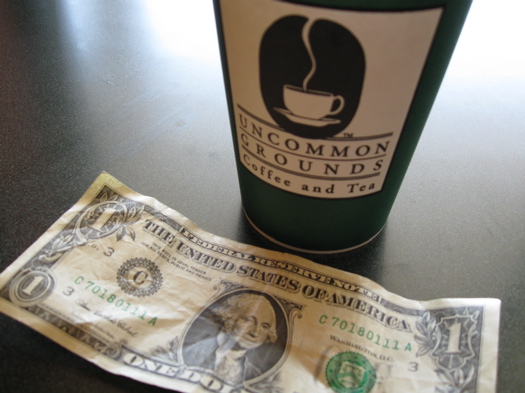
A dollar goes surprisingly far these days.
Dollar bills. They're stashed in pockets, thrown in tip jars, exchanged for all sorts of things, and rest snugly in a cash drawer at the end of the day. No one thinks about the much. They're a means to an end--that end being a lottery ticket or a latte. Essential.
You may not think about your dollars much, but many people do, and a lot of them live here in the Capital Region. The Web site Where's George? is dedicated to tracking the movements of paper money. A stamp or other marking on a registered bill directs observant consumers to the site, where they enter the serial number on the bill and learn about its sordid past.
With over 148 million pieces of United States currency logged in the Where's George database, some of them have inevitably passed through the region. Curious, I ran a random sample of local Zip codes through the database to see exactly where those bills have been. What follows is an entirely unscientific random sample of where our friends and neighbors have been spending their cash in February and March of 2009.
State budget talks appear to be stalling, police commander: no-fine stickers date back 17 years, home prices down again, school district worried about backyard wrasslin'
The Three Men in the Room say they're struggling to reach consensus on the state budget. (Of course, it's hard to tell if that's true or not because all the negotiations are going on behind closed doors.) The budget is due April 1. [NYT]
State Senator Hiram Monserrate, a Democrat from Queens, was indicted yesterday on charges that he slashed his girlfriend with a broken glass. Monserrate says he's innocent and will not resign. The Democrats hold a two seat majority in the Senate. [TU][NYT]
Chuck Schumer says he now supports gay marriage. The New York US Senator had been a supporter of civil unions and vote for the federal Defense of Marriage Act (which forbids federal recognition of gay marriages) in 1996. [AP/NYT]
An Albany police commander testified before the Common Council last night that the "bull's eye" no-fine parking stickers date back to 1992 -- and were administered by the Albany Police Officers Union. The head of the APOU at that time: current police chief James Tuffey. [TU]
The median sales price for a home in the Capital Region fell five percent (to $176,000) in February compared to the same period last year, according to the Greater Capital Association of Realtors. [TU]
Yep, the job picture is not good right now
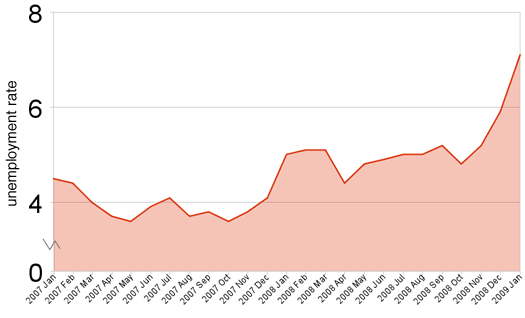
The last two years. (Data from NYS Dept of Labor)
The state Department of Labor released unemployment figures today -- and they were not good. "Flabbergasted" was the word used by the state labor commissioner.
The unemployment rate in the Albany-Schenectady-Troy metropolitan area was 7.1 percent in January. That's up from 5.9 percent in December and 5.1 percent last January.
The numbers appear a little worse than they might otherwise look because the labor department includes Schoharie County in the Capital Region's metro area -- and Schoharie's unemployment rate was 11.3 percent in January. The other counties were all between 6.7 (Albany and Saratoga) and 7.6 (Rensselaer).
Statewide, the unemployment rate was 7 percent. Nationally, it was 7.6 percent.
For some perspective, we've put together a 10 year chart of Capital Region unemployment. It really shows how far outside "normal" we are right now.
Planning for stimulus funds, River Rats bus flips on Mass Turnpike, restaurants cutting prices, no Whitney Gala this year

Sadly, the state's war room doesn't look like this. Remember: you can't fight in the war room.
The Paterson Administration has set up a "war room" to coordinate the state's administration of the roughly $25 billion in federal stimulus money headed this way. [TU]
Buried among the list of new taxes and fees in the Paterson budget proposal: a $10 fee for filing your state tax return on paper. More than 40 percent of state tax returns in New York State were filed on paper last year. [TU]
The Capital District Transportation Committee has put together a list of local infrastructure projects that should qualify for stimulus funding -- a group that totals about $87 million. Among the projects on the list: the reconstruction of Delaware Ave in Albany and the replacement of the Bridge Street bridge in Cohoes. [TU]
Three people from the Albany River Rats were seriously injured this morning after the team bus rolled over on the Mass Turnpike. The team was returning from a game in Lowell. [TU] [Daily Gazette]
From the very special election to fill Kirsten Gillibrand's old House seat... Republicans are criticizing Scott Murphy for not voting in eight primary and general elections between 2000 and 2003. And Jim Tedisco participated in a "tele town hall meeting" yesterday -- basically, the campaign robo-called 30,000 people and told them if they held on, Tedisco would speak and answer questions live. The campaign says it had as many as 6,000 people on the line at one point. [Daily Gazette] [Daily Gazette] [CapNews9]
Top Schenectady city officials are demanding to know how the cop accused of serially spending hours in an apartment when he was supposed to be on patrol could have gotten away with it. This latest scandal is just the latest in a long list of Schenectady Police Department screw-ups. [Daily Gazette] [TU]
Job openings attracting many applicants, tax trouble for legislators, wig-wearing would-be test taker won't be charged with felony, libel suit against TU dismissed
Local employers say they're seeing a flood of applications for open jobs. [Daily Gazette]
The former state employee who blew the whistle on Antonia Novello says he was framed for speaking out against the former Department of Health commissioner. [TU]
A Schenectady police officer topped the list of the city's highest paid employees last year. His $168,922 in gross salary was a department record. Mayor Brian Stratton's $97,000 ranked him 74th on the highest-paid list. [TU]
It seems that members of the state legislature have trouble paying their taxes. Twenty current members have had "tax warrants" issued for them at some point. [TU]
During the first 12 hours of this most recent snow emergency, 226 cars were towed in the City of Albany. [Fox23]
A jury convicted an Albany woman of conspiring to murder her ex-husband in 2007. The woman is now facing 25 years to life in prison. [TU]
Paterson says he's narrowed the field for Clinton's seat, storms straining snow removal budgets, shootout in Schenectady, dry cleaner closing stores
David Paterson says he's narrowed the field of candidates to replace Hillary Clinton in the Senate, but says he still hasn't made up his mind -- though he expects to do so by the end of this week. Paterson says he hasn't yet gone through all the questionnaires submitted by the hopefuls. [TU] [NYT]
One way you might have scored an inauguration ticket from Kirsten Gillibrand: promise to "love you so much" in a handwritten letter. It probably helps to be 10-years-old, too. [TU]
A rapid exchange of gunfire yesterday afternoon in Schenectady left bullet holes in cars and sent neighborhood residents diving for the floor. The shooters got away before police arrived. [TU] [Fox23]
Increased prices for salt -- and a series of weekend snow storms -- are straining the snow removal budgets of local municipalities. [Daily Gazette]
Timmons found guilty, Gillibrand says she is a candidate for Clinton's seat, Jackson talks with RPI faculty about recent layoffs, local foreclosures up in 2008
Note: the TU's site was down this morning
A jury found Jermayne Timmons guilty yesterday of firing the shot that killed Kathina Thomas. The teen could now get 15 years to life. Timmons' lawyer says they plan to appeal. Thomas' mother says she hopes Timmons is sent away for life. Charlie Muller, who runs the Albany gun buyback program, says both Thomas and Timmons are victims of the situation. [AP/Daily Gazette] [Fox23] [CapNews9]
Kirsten Gillibrand said yesterday that she is a candidate for the Hillary Clinton's Senate seat and she has interviewed with David Paterson about the job. [CBS6] [Post-Star]
The City Mission of Schenectady says demand for meals and a place to stay was up signficantly last year. And the recent cold weather is also increasing demand -- the shelter laid out mats for extra people last night. [Daily Gazette] [Daily Gazette]
It appears that the Albany area is currently the top candidate for a new IBM research center that would employ 675 people. [EETimes] [Daily Gazette]
Job anxiety at Capitol, Albany Med planning more development, cell phone prompts school evacuation, NYSTI fighting merger with Egg
The change in control of the state Senate is causing a lot of anxiety for staffers -- many of their jobs are up in the air as resources are being re-apportioned. The state Senate has 1,300 staffers. [NYT]
Albany Med is looking to build an office building, hotel and parking garage on land owned by the VA across New Scotland Ave. The plan would also reconfigure that part of New Scotland into a four-lane street. [TU]
A chunk of ice flew off the back of a tractor trailer yesterday and smashed through the windshield of a Ballston Spa woman's car. (The picture is remarkable.) She says she'd now like to see a state law to making it illegal to drive with ice on your car. [CBS6] [CBS6]
Local auto repair shops say business is booming as people look to hang on to their cars longer because of the economy. [TU]
Police say they're not sure what led to the death of a man found along the side of the road in North Greenbush on Sunday. [Troy Record]
State of the State today, Democrats organize control of state Senate, unemployment claim system crashes, two-year-old found wandering snowy streets
David Paterson will deliver the state of the state speech today at 1 pm. A group of labor unions representing state, local and healthcare workers is planning a march through downtown Albany before the speech -- traffic is being re-routed as thousands are expected to take part. Paterson has largely been out of sight the last few weeks because he's needed the time -- some 60 hours -- to memorize his speech. [TU] [Daily Gazette] [CBS6] [Daily Politics] [ABCNews]
It appears the Democrats have worked out an arrangement to take control of the state Senate. The deal may -- or may not -- have included an agreement to block a vote on same-sex marriage. Malcolm Smith will become the state's first African-American Senate majority leader. And with the change of party control, there are a bunch of new committee chairs -- including the guy who was recently charged with felony assault. [NYT] [TU] [NYDN] [Daily Politics] [NYT]
On the first day of testimony in the trial of the teen accused of firing the shot that killed Kathina Thomas, a prosecution witness admitted he had lied during his testimony. The girl's mother also testified yesterday and her account of the incident was heartbreaking. During opening arguments, the attorney for the accused teen said his client did fire a shot that day -- but not with the type of gun police say killed Thomas. [TU] [AP/Daily Gazette]
Paterson annoyed by Senate chatter, horse found murdered, mortgage rates way down, shoe repair business way up
David Paterson says the chatter about who will get Hillary Clinton's Senate seat has "reached a new high and new low in areas of gossip, speculation, mind-reading." A Q poll reports that the public thinks Paterson will appoint Caroline Kennedy -- a conclusion that apparently frustrates the Gov. [TU] [Quinnipiac] [NYT]
The attorneys for a Troy man accused of killing his infant son in September say charges against their client should be dropped because the child named in the indictment is actually the deceased infant's twin brother -- who's still alive. [TU]
The chairman of CDTA's board says he realizes the 50 cent fare hike will be difficult for some people, but the transit org had "no other alternatives." [TU] [Daily Gazette]
A horse in Hoosick Falls was found dead this week, its throat slashed during what appears to have been an attempted robbery. [Troy Record]
Totaling up the "other" taxes
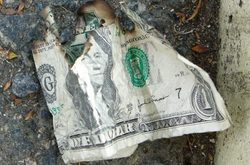 The state Assembly Republican Ways and Means Committee (apparently they had to start their own) has put together an estimate of how much increased fees and the "other category" taxes in David Paterson's proposed budget would cost "the average New York family." (We found it on Jim Tedisco's blog -- a copy is also posted after the jump.)
The state Assembly Republican Ways and Means Committee (apparently they had to start their own) has put together an estimate of how much increased fees and the "other category" taxes in David Paterson's proposed budget would cost "the average New York family." (We found it on Jim Tedisco's blog -- a copy is also posted after the jump.)
The analysis concludes that the taxes on items such as soda and music downloads will cost that average family $3,875.48 a year.
Bank robbery involves chase, fake beard and -- possibly -- gunfire, local unemployment rate up again, DA says RPI student's death a mystery, that's not Jimmy Tedisco
State police say a man, wearing a "a fake Abe Lincoln-style beard," robbed a bank in Latham at gunpoint yesterday afternoon before leading cops on a high-speed chase up the Northway and into Saratoga. They say the man the sped down Rt. 50 before striking another vehicle and flipping his SUV. Police are also investigating whether gunfire was exchanged -- there are indications a state trooper did fire his weapon. [TU] [Daily Gazette] [Saratogian] [Post-Star] [TU]
The Capital Region's unemployment rate hit its highest point for a November (5.2 percent) since 1992's November. Retail jobs have been among the hardest hit. A state labor department analyst says he expects the numbers to get worse, but compared to the rest of the country, they're not that bad. [Biz Review] [Daily Gazette] [TU]
The number of calls last month to the state's unemployment insurance call center was almost triple that of the same period a year ago -- and as a result, about 40,000 calls went unanswered. Things are so bad the head of the center asked the TU not to reveal its location for fear that angry people would show up at the building. [TU]
Plug Power laid off 90 workers yesterday, most of them at its Latham headquarters. [Biz Review]
A quick read of Paterson's proposed budget
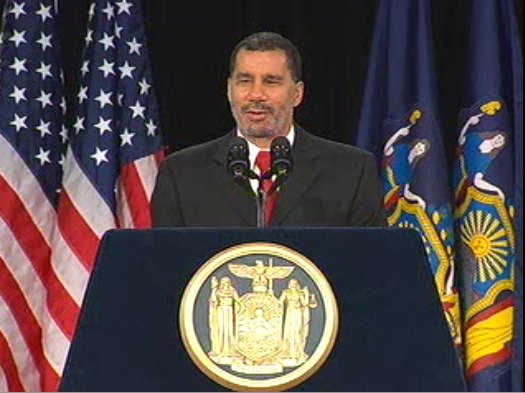
David Paterson at today's budget proposal release.
David Paterson released his proposed 2009-2010 budget today. In a short speech, Paterson reiterated that this is the worst fiscal crisis the state has faced since The Great Depression. He also said the proposed budget is not perfect and that he welcomes critiques and other ideas -- though he said that "endless ridicule" is not helpful.
Here's a very quick summary.
Ice storm knocks out power, violence at Albany High said to be out of control, Freihofers sold, alleged puppy-napping in Troy
Note: The Daily Gazette's website wasn't loading this morning.
Updated: 11:25 am
The ongoing ice storm has knocked out power for about 160,000 National Grid customers in the four core counties of the Capital Region (that figure is from National Grid's website this morning at 11:25 am). National Grid says it has 150 crews in the area working on repairs. [National Grid] [TU]
An anonymous Albany High School employee tells CBS6 that violence is out of control at the school. Among the incidents collected from police reports this school year: a teacher has been pushed to the ground and kicked, another teacher was punched repeatedly in the ribs, there was a three-on-one student beating, and two students hit another student in the back of the head with a padlock. [CBS6]
An anonymous source tells the TU that "ghost" parking tickets have been circulating in the City of Albany since the early 1990s -- and the stickers that marked a car as being eligible for the no-fine tickets were distributed by the Albany Police Officer's Union. Current police chief James Tuffey was president of the union in the early 90s, but he says he never knew about the stickers. [TU]
One upside to the slowing economy: the price of electricity and natural gas is falling. The price National Grid is charging for a kilowatt hour of electricity has dropped about 15 percent over the last year. [TU]
Layoffs coming to RPI
The announcement came in a mass email sent out by Shirley Jackson this afternoon. From the email (emphasis ours):
As the economy has worsened, and we have analyzed how it has affected, and will continue to affect, Rensselaer, we have determined that it will not be possible to reduce the budget sufficiently without reducing our recurring compensation expenses, which make up half of the Institute's operating budget. Staffing reductions will be necessary. We would prefer to rely on attrition, but it will not be adequate to meet our financial objectives. Each vice president and portfolio owner has examined their respective operations for reductions in staff, in a way that will enable greater efficiency, improved performance, and elimination of redundancy. We will manage the required staffing reductions as compassionately as possible. We will take such steps in the coming week.
There's already a hiring freeze in place at the school. According to the email, RPI is projecting downturns in income from tuition, gifts, research funding, and endowment.
The full email is after the jump.
Democrats strike deal for control of state Senate, Schumer touting Gillibrand, longtime Saratoga sheriff gets challenger, wrong way driver causes four accidents, students organize for french fries
Note: the TU's site wasn't loading this morning.
Democrats in the state Senate have worked out a deal with the "Gang of Three" senators who were threatening to side with Republicans in the upcoming leadership vote. As part of the deal, Malcolm Smith will become head of the state Senate (president pro tem), but Pedro Espada will become majority leader (no, it usually doesn't get split like that). Also apparently part of the deal: the chamber won't bring up a vote on gay marriage, which one of the Gang of Three opposes. [NYT] [NYDN] [NYP]
Chuck Schumer is reportedly encouraging David Paterson to pick Kirsten Gillibrand to replace Hillary Clinton. [NYP]
The solider from Rensselaer County accused of killing two superiors in Iraq was found not guilty by a military jury yesterday at Ft. Bragg in North Carolina. The judge had to clear the courtroom after the verdict prompted yelling from the victims' families. [AP/Daily Gazette]
Police say bystanders flocked to the aid of the family hit by a pickup truck on State Street in Schenectady Wednesday. An SPD spokesperson says the accident scene was one of the worst he's ever seen, with little kids "lying in the street screaming for their mother." [Daily Gazette]
Kaczmareks got "family plan" plea deal, early retirment incentives for state workers?, drug stores everywhere, bus fare price war
The attorney for former Schenectady police chief Greg Kaczmarek says prosecutors offered Kaczmarek and his wife the "family plan" plea deal in their drug cases -- and that Kaczmarek took a longer term in prison to shorten the term for his wife. As part of the deal, Greg Kaczmarek was sentenced to two years in prison -- but he could be out in 17 months with good behavior. [Daily Gazette] [TU]
The state legislature is reportedly working on a plan that would offer early retirement incentives to state workers as a way of trimming the state payroll. David Paterson says he's not on board with the plan. [AP/TU]
David Paterson is currently being treated like the "prom queen" as people lobby him about the decision of whom to appoint to Hillary Clinton's Senate seat. [NYT]
Albany police say a group of "backpack bandits" (the TU's phrase) may be responsible for a string of muggings around the city. The group may have been in involved in a reported robbery late Monday afternoon in a which a man says five muggers stopped his car, bashed him in the head with a gun, and stole $2000. [TU] [Troy Record]
Former Schenectady police chief to plead guilty, chip fab clears another hurdle, Paterson "disturbed" by list, Jumpin' Jacks waterfront to get makeover
Both former Schenectady police chief Greg Kaczmarek and his wife are expected to plead guilty today to drug charges. The former top cop is expected to get two years in prison as part of the plea deal. [Daily Gazette]
State police incorrectly identified the victim in a fatal car crash over the weekend in Clifton Park. The mix-up led to the wrong family being notified. The situation was resolved after the grandmother of the man who actually did die noticed something was wrong. [TU]
Super Steel is closing its plant in Glenville. The manufacturer of train cars says it's seen "a steep decline in orders." The shutdown will put 175 people out of work. [TU] [Daily Gazette]
The Malta chip fab project cleared another hurdle yesterday. The Empire State Development Corp. approved the transfer of $1.2 billion in state incentives from AMD to the new spin-off company that will run the plant. [Daily Gazette]
Home prices holding steady, Jennings starts up re-election campaign, RPI center will focus on extraterrestrial life, family gets Oprah makeover
The median sale price of homes in the Capital Region is holding more or less steady, even as many fewer houses are being sold. The number of sales in October was down 16 percent over the same period a year ago. [Biz Review] [TU]
New York State comptroller Tom DiNapoli is predicting the state could lose 225,000 jobs during the next two years. DiNapoli says about 3/4 of the lost jobs will come from Wall Street -- which could take a big bite out of state revenue. About 20 percent of state tax revenue comes from the Street. [TU]
The Albany Common Council approved a 2009 budget for the city. The budget includes a tax increase of $96 for the average homeowner. [TU]
Saratoga Springs' finance commissioner has proposed a new 2009 budget that takes into account the proposed cut in VLT money from the state. The new budget includes a tax increase of 3.5 percent -- up from 2.7 percent in the previous version. [Saratogian] [Daily Gazette]
Jerry Jennings' 2009 re-election campaign is starting up, apparently with some haste. The Albany mayor's campaign will be holding a fundraiser at the Fort Orange Club in December -- $500/person for the cocktail reception, $1000/person for dinner. [TU]
Family's SUV hit twice by trains, proposals include paying for parking in Saratoga, road salt costs up, state saving money on tree lighting
A father and his two daughters escaped with just a few cuts and bruises after two trains hit their SUV. The father said he never saw the trains coming as he drove through a train crossing near their home in New Scotland Saturday morning. The two collisions knocked the front and back ends off the SUV. The crossing has no signals -- the father says he'd been pushing the town and the train company to change that. [TU] [Troy Record] [Fox23] [Fox23]
Two of the three development proposals for the new public safety building in Saratoga Springs include plans to charge for downtown parking. And it looks like those two proposals, which also include plans for a movie theater, are the two leading candidates. The president of the Downtown Business Association called the idea of charging for downtown parking "ridiculous." [Daily Gazette] [TU] [Saratogian]
There have been a lot of shots fired in Albany over the past few days. Last Thursday evening, police say a man fired a shot inside a neighborhood grocery on Ontario St. On Saturday, police say three men conducted a bike-by shooting on South Lake near the uptown end of Washington Park (the gunmen missed). And then on Sunday, a man was shot in the butt while he was standing at the corner of Lark and Livingston. [Daily Gazette] [Troy Record] [CBS6]
Albany County officials are pushing for a 30 cent per month tax on mobile phones to help cover the cost of operating 911. Many other local counties already have such a tax. [TU]
Unemployment rate up over a year ago, Soares looks to crack down on DWI, Troy stores will be on Oprah, DiNicola has a brain tumor
The Capital Region's unemployment rate in October was 4.9 percent, up from 3.6 percent a year ago. [TU]
A Siena poll reports that a majority of New Yorkers are planning to spend less this year on holiday presents. [Daily Gazette]
A Thanksgiving food bank in Schenectady says requests are up about 20 percent this year. [Daily Gazette]
Albany County DA David Soares says his office will be cracking down on drunk drivers and will push to seize the cars of DWI suspects. [TU]
The mayor of Rensselaer says the city will not be prepared to handle snow removal this winter after the city council voted down a plan to use state money to replace equipment damaged during summer flooding. The council president says the city hasn't adequately documented what was lost. [TU] [Troy Record]
More people looking for work?
 Updated 10:20 am Friday
Updated 10:20 am Friday
The state released last month's unemployment data today. The short story: the Capital Region's unemployment rate in October was 4.9 percent -- that's up from 3.6 percent in October of last year.
OK, so maybe that's not surprising given the way the economy's been going. But get this: the number of jobs in the Capital Region over that time period didn't change.
Huh?
State leaders meet and get nothing done, Troy needs a fire truck, UAlbany students charged with rape, truck hits overpass
David Paterson, Sheldon Silver and Dean Skelos met up on Sunday to discuss possible budget cuts ahead of tomorrow's special legislative session. And the result: nothing. [TU]
Saratoga Springs city officials say they'll be lobbying state leaders this week in an attempt to keep all of the VLT money originally allotted to the city. David Paterson's proposed budget cuts would cut $1.9 million from the city's share of VLT revenue -- that's five percent of the city budget. [Daily Gazette]
Seemingly half of New York's Congressional delegation -- not to mention a handful of other state officials -- could be in the running for an appointment to Hillary Clinton's Senate seat in the event she takes a post with the Obama Administration. Oh, and about that -- Clinton's not talking. [TU] [TU]
Troy's deputy mayor says the city's fire chief sent him a letter last week reporting that the city is in emergency need of a new fire truck after two of the trucks were recently taken out of service. [Troy Record]
A quick read of the Paterson budget plan
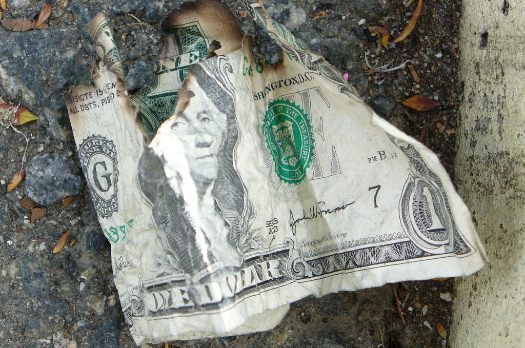
David Paterson unveiled his plan for cutting $2 billion from the current state budget today. He says this plan will cut $2 billion from this year's budget and $3.2 billion from next year's (in which a $12.5 billion gap has already been projected).
We've put together a quick rundown of the cuts/savings. It includes some possibly bad news for Saratoga.
Paterson says budget cuts will involve "a big knife," state economy in recession, recycling urged in effort to save money, proposed Saratoga horse park would be pricey
At a town hall-style meeting yesterday Syracuse, David Paterson said of making cuts to the state budget: "We'll be using a big knife but trying to operate it like a scalpel." The Gov will unveil his plans for cutting $2 billion from the current state budget this morning. Reportedly among the proposals: across-the-board cuts for health programs, big cuts to public universities, a repeal of the gasoline tax cap and increase in fees for health plans. [NYT] [TU]
The leadership situation in the state Senate is still unsettled. One of the three Democrats who have not pledged their support to Malcolm Smith says he'd prefer to see a Latino Democrat be majority leader. [NYT]
An analysis from a University at Buffalo center has concluded that New York State has been in a recession since the second quarter of this year. [Biz Review]
Local retail stores are hiring extra help for the holidays shopping season -- and this year they have their pick of employees. [AP/TU]
Stacking up tax increases
 All around the Capital Region, municipalities are getting their budgets ready for next year. And you know what that often means -- yep, tax increases.
All around the Capital Region, municipalities are getting their budgets ready for next year. And you know what that often means -- yep, tax increases.
We've pulled together a list of proposed tax increases from around the area. It's not a comprehensive list, but it gives you a sense of how things are stacking up.
Local unemployment rate hits 13-year high, candidates debate energy issues, pharmacy college changes its name, yet another new hotel
The Capital Region unemployment rate was 5.2 percent in September -- that's up from 3.8 percent a year ago. It's the highest unemployment rate for the area in 13 years. [TU] [Daily Gazette]
Jim Buhrmaster and Paul Tonko, the two candidates for the 21st Congressional District (McNulty's seat), talked a lot about energy during their debate last night. Both have experience on the topic -- Buhrmaster's family owns a heating oil company and Tonko was head of NYSERDA. Buhrmaster said new drilling for oil should one of the first priorities in a national energy plan and Tonko said it should be one of the last. [TU]
Still to come in the race between Kirsten Gillibrand and Sandy Treadwell for the 20th Congressional District: a lot of TV ads. [Daily Gazette]
A former deli worker at the Sam's Club in Latham is suing Walmart (Sam's parent company) for $1 million. The man says he was fired because he's a Catholic who wanted Sundays off to go to church. He says Walmart told him he was being fired for misconduct. [TU] [Daily Gazette]
Local economy OK... for now, Gillibrand talks about tobacco industry work, bridges described as "structurally deficient," neighbors fight over tree
How's the local economy? Not so bad, say business owners and other experts. But the future may be another thing. [TU] [Daily Gazette]
Kirsten Gillibrand addressed her time as a lawyer representing tobacco company Philip Morris yesterday. Campaign finance records indicate she's received at least $16,700 from executives connected to the company (which is now called Altria) -- Gillibrand says she wasn't aware the company had contributed. Gillibrand's history with the company has been publicized recently by a former Pataki aide on a blog and in comments on other blogs (including here on AOA). Gillibrand's opponent in this year's election is Sandy Treadwell, who served as NY secretary of state during the Pataki administration. [TU] [OpenSecrets]
Those 4-foot by 8-foot Treadwell campaign signs are OK as long as they're on private property, according to Clifton Park's director of building and zoning. Democrats there had complained the signs violated zoning rules. [Daily Gazette]
A memo released by federal prosecutors alleges that former state assemblyman Chris Ortloff said "... honestly I don't have a moral problem with this ... " about his desire to have sex with tween girls. The now former member of the state parole board was arrested in Colonie this week after a sting operation. [TU]
Is the Capital Region in a recession?
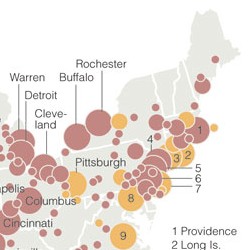 According to an analysis by Moody's Economy.com, the answer is: yes.
According to an analysis by Moody's Economy.com, the answer is: yes.
The designation comes from an evaluation of employment and production data. To be "in recession," as Economy.com terms it, an area's economy must be showing contraction over a six month period. By that measure, Economy.com figures about two-thirds of metro areas in the country, including the Capital Region, are in recession. (NYT has a map, a clip of which is to the right. Red means "in recession," yellow means "at risk.")
The US as a whole is not officially in recession -- at least, not yet. That designation is made by the National Bureau of Economic Research, which isn't currently using the "r" word.
map excerpt: New York Times
... said KGB about Drawing: What's something that brought you joy this year?